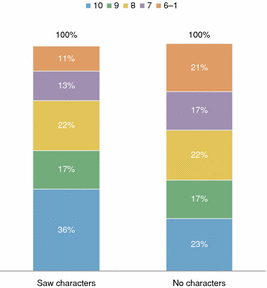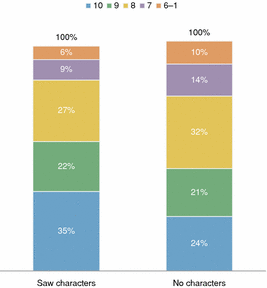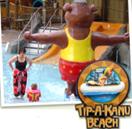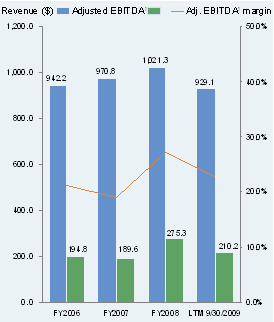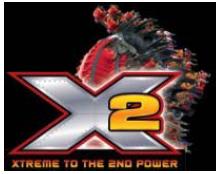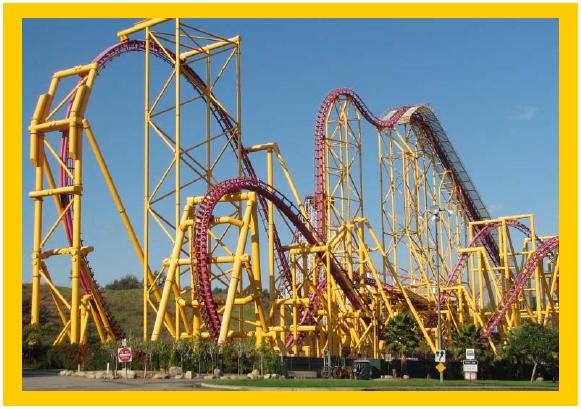Attached files
| file | filename |
|---|---|
| 8-K - 8-K - Six Flags Entertainment Corp | a10-1359_18k.htm |
| EX-99.2 - EX-99.2 - Six Flags Entertainment Corp | a10-1359_1ex99d2.htm |
Exhibit 99.1
JANUARY 2010
STRICTLY PRIVATE AND CONFIDENTIAL

SIX FLAGS THEME PARKS
$830,000,000 Exit Facility
CONFIDENTIAL INFORMATION MEMORANDUM FOR PUBLIC-SIDERS
See Special Notice on next page
|
|
|
|
|
CONFIDENTIAL
SIX FLAGS THEME PARKS
Table of contents
|
1. |
Executive summary |
3 |
|
|
Transaction overview |
3 |
|
|
Company overview |
3 |
|
|
Summary organization chart |
5 |
|
|
Current and pro forma capitalization |
5 |
|
|
Sources and uses |
6 |
|
|
Description of Exit Facilities |
6 |
|
|
Recent events |
7 |
|
|
Plan of Reorganization summary |
8 |
|
|
Postconfirmation governance |
10 |
|
|
Industry overview |
10 |
|
|
Partnership Parks overview |
11 |
|
|
Time Warner financing |
11 |
|
|
Historical financial summary |
12 |
|
|
2009 Financial highlights |
13 |
|
2. |
Key investment considerations |
14 |
|
|
Geographic diversity |
14 |
|
|
High barriers to entry |
14 |
|
|
Valuable advertising platform |
14 |
|
|
Sponsorship revenue opportunities |
15 |
|
|
Attractive IP portfolio |
16 |
|
|
Well-invested portfolio of state of the art rides |
18 |
|
|
Favorable industry characteristics |
19 |
|
|
Well-balanced capital structure |
19 |
|
|
Strong collateral coverage |
19 |
|
|
Proven management team |
20 |
|
|
Recent operational improvements position the Company for growth |
20 |
|
3. |
Partnership Parks overview |
22 |
|
4. |
Summary of terms and conditions |
26 |
|
5. |
Form of commitment advice |
27 |
|
6. |
Administrative questionnaire |
28 |
|
7. |
Business description |
29 |
|
8. |
Industry overview |
37 |
|
|
Industry composition and recent performance |
37 |
|
|
Industry outlook |
39 |
|
9. |
Management team |
40 |
|
|
Team overview |
40 |
|
10. |
Historic and financial overview |
42 |
|
11. |
Financial Projections |
45 |
|
|
Projected balance sheet |
47 |
|
|
Projected operations |
48 |
|
12. |
Long Range Plan and Financial Projections |
55 |
|
|
Long range plan assumptions and drivers |
56 |
|
13. |
Appendix |
59 |
|
|
Definitions: Modified EBITDA, Adjusted EBITDA, and Free Cash Flow |
59 |
|
|
Description of major parks |
61 |
CONFIDENTIAL
1. Executive summary
Transaction overview
Six Flags, Inc. and certain of its subsidiaries (collectively with its non debtor subsidiaries, “Six Flags” or the “Company”) filed for Chapter 11 protection in Delaware on June 13, 2009. The Company filed a fully-funded Plan of Reorganization (“POR” or the “Plan”) with the Bankruptcy Court on December 18, 2009 that includes a $450 million rights offering (the “Rights Offering”) backstopped by certain bondholders of Six Flags Operations Inc., an intermediate holding company (“SFO”). As part of the POR, the Company has mandated J.P. Morgan, Bank of America, Barclays and Deutsche Bank as Joint Bookrunners and Joint Lead Arrangers to arrange $830 million in Senior Secured Credit Facilities (the “Facilities” or the “Exit Facilities”) to finance the Company’s exit from bankruptcy. The Facilities consist of a $150 million Revolving Credit Facility (the “Exit Revolving Credit Facility”) and a $680 million Term Loan (“Exit Term Loan”). The Plan also features a financing commitment of $150 million from Time Warner (related to funding certain obligations) and has the support of the Steering Committee of the Company’s pre-petition secured creditors. Confirmation of the POR is expected to occur in March 2010, with Six Flags expected to emerge from bankruptcy shortly thereafter.
Company overview

Six Flags is the largest regional theme park operator in the world. The Company owns or operates 20 parks located in diverse markets across North America, including 18 domestic parks, one park in Mexico City, Mexico and one park in Montreal, Canada, and attracted 25.3 million visitors in 2008. The parks offer a complete family-oriented entertainment experience with a broad selection of state-of-the-art and traditional thrill rides, water attractions, themed areas, concerts and shows, restaurants, game venues and retail outlets. During 2008, Six Flags theme parks offered more than 800 rides, including over 120 roller coasters, making Six Flags the leading provider of “thrill rides” in the industry. The Company’s parks are located in diverse markets across North America, with no single park accounting for more than 13% of revenue or 18% of Modified EBITDA(1) in 2008. The parks are primarily marketed to guests who live within 100 miles, and the Company’s primary markets include nine of the top ten designated market areas (“DMAs”) in the United States.
Six Flags North American Footprint
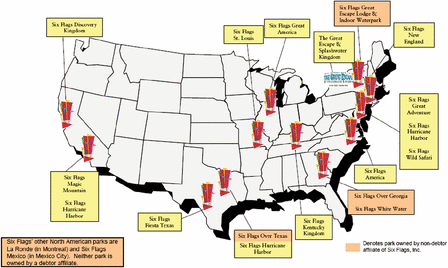
(1) As defined in the Appendix
CONFIDENTIAL
Intellectual Property Rights

Six Flags holds exclusive long-term licensing rights to use certain Warner Bros. and DC Comics characters throughout the United States (excluding the Las Vegas metropolitan area), Canada, Mexico and other countries. These characters include Bugs Bunny, Daffy Duck, Tweety Bird, Yosemite Sam, Batman, Superman and others. In addition, Six Flags has certain rights to use Hanna-Barbera and Cartoon Network characters, including Yogi Bear, Scooby-Doo, The Flintstones and others. The Company uses these characters to market the parks and to provide an enhanced family entertainment experience. The licenses include the right to sell merchandise at the parks featuring the characters, and to use the characters in advertising and marketing materials, as walk-around characters and in theming for rides, attractions and retail outlets. The Company believes that using these characters promotes increased attendance, supports higher ticket prices, increases length of-stay in the parks and enhances in-park spending.
Corporate Alliances and Sponsorships

With approximately 25 million guests per year, Six Flags provides a strong platform for future sponsorship opportunities to reach a broad captive audience. As a result, Six Flags has increased sponsorship, licensing and other fees from approximately $16 million under contract at the time new management was installed in late 2005 and early 2006 to approximately $59 million for 2008. In 2009, the Company held over 40 national and regional deals and over 320 local park-specific partnerships, with brands such as Johnny Rockets, Papa John’s pizza, Coca Cola, and many others. These relationships typically include annual sponsorship fees, direct marketing opportunities and provide multiple marketing touch points for Six Flags. Additionally, the Company improves its reputation by associating itself with high quality brands.
dick clark productions, inc. (“dcp”)
and
Six Flags Great Escape Lodge & Indoor Waterpark (“HWP”)

On June 18, 2007, Six Flags acquired an original 40% interest (subsequently reduced to 39.2%) in a venture that owns dcp, an entertainment production company that is responsible for the development and production of a number of television shows, including American Bandstand, TV Bloopers & Practical Jokes, and Dick Clark’s New Year’s Rockin Eve and awards shows such as The American Music Awards, the Academy of Country Music Awards, and the Golden Globe Awards. Six Flags is paid an annual fee to manage dcp. In addition, Six Flags currently manages and owns a 41% interest in HWP, a hotel-indoor water park located in Lake George, New York, which is adjacent to the Company’s wholly-owned Great Escape theme park.
CONFIDENTIAL
Summary organization chart
The chart below summarizes Six Flags’ organizational structure. Six Flags Theme Parks Inc. (“SFTP”), which owns and operates 17 of the 20 parks, will be the Borrower under the Exit Facilities. The Exit Facilities will benefit from downstream guarantees from Six Flags, Inc. (“SFI”), its ultimate parent company, and SFO, its direct parent company, as well as upstream guarantees from the domestic subsidiaries of SFTP. The three remaining Six Flags parks, Six Flags Over Texas, Six Flags Over Georgia, and Six Flags White Water Atlanta (collectively the “Partnership Parks”), are partly owned by SFI through limited partnership structures and are operated by subsidiaries of SFI. Indirect subsidiaries of SFI (the “Acquisition Parties”) will be and are the borrowers under the new and existing Time Warner facilities, respectively. SFI, SFO, and SFTP are guarantors of the Existing TW Loan (as hereinafter defined) in an amount up to $10 million, and SFI, SFO, SFTP, and each of SFI’s domestic subsidiaries that become guarantors under the Exit Facilities will be guarantors of the New TW Loan (as hereinafter defined).
Summary organizational chart
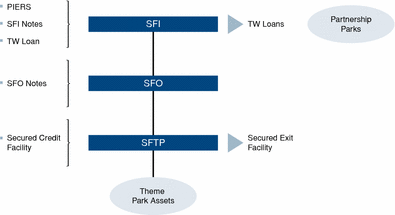
Current and pro forma capitalization
The Six Flags capital structure, including leverage statistics, as of September 30, 2009 and pro forma following emergence from Chapter 11 is set forth below:
Summary capital structure ($ millions)
|
|
|
Amount |
|
x 2009PCA |
|
|
|
Minimum cash balance |
|
$ |
40 |
|
|
|
|
Six Flags Theme Parks Inc. |
|
|
|
|
|
|
|
$275MM revolver(1) |
|
272 |
|
|
|
|
|
$850MM term loan facility(1) |
|
839 |
|
|
|
|
|
Interest rate swap and LOCs |
|
22 |
|
|
|
|
|
Subtotal SFTP |
|
$ |
1,133 |
|
5.5x |
|
|
Six Flags Operations Inc. |
|
|
|
|
|
|
|
12.25% SFO senior notes(1) |
|
420 |
|
7.5x |
|
|
|
Six Flags, Inc. |
|
|
|
|
|
|
|
Unsecured SFI notes(1) |
|
898 |
|
|
|
|
|
Existing TW Loan(3) |
|
41 |
|
|
|
|
|
Other |
|
3 |
|
|
|
|
|
Subtotal SFO and SFI |
|
$ |
1,362 |
|
12.1x |
|
|
PIERS preferred stock |
|
307 |
|
|
|
|
|
Total debt including PIERS |
|
$ |
2,802 |
|
13.6x |
|
|
|
|
Amount |
|
x 2009PCA |
|
|
|
Minimum cash balance |
|
$ |
40 |
|
|
|
|
|
|
|
|
|
|
|
|
|
|
|
|
|
|
|
|
$150MM revolver |
|
88 |
|
|
|
|
|
$680MM term loan facility |
|
680 |
|
|
|
|
|
Subtotal SFTP |
|
$ |
768 |
|
3.4x |
|
|
Six Flags Operations Inc. |
|
|
|
|
|
|
|
|
|
|
|
|
|
|
|
Six Flags, Inc. |
|
|
|
|
|
|
|
New TW Loan(4) |
|
— |
|
|
|
|
|
Existing TW Loan(3) |
|
30 |
|
|
|
|
|
Other |
|
10 |
|
|
|
|
|
Subtotal SFO and SFI |
|
$ |
40 |
|
3.6x |
|
|
|
|
|
|
|
|
|
|
Total debt |
|
$ |
808 |
|
3.6x |
|
(1) 12.25% SFO senior notes and unsecured SFI notes include accrued interest through June 12, 2009, default interest on term loan and revolver accrued through September 30, 2009
(2) Projected 2009 Cost Adjusted EBITDA of $206MM, which comprises the projected 2009 Adjusted EBITDA of $190MM and $16MM in additional cost savings projected for 2010 applied to such projected 2009 Adjusted EBITDA
(3) $10MM guarantee by SFI, SFO and SFTP of the Existing TW Loan
(4) Guaranteed by SFI, SFO, SFTP and each of SFI’s wholly owned subsidiaries that become guarantors under the Exit Facilities
(5) Leverage calculated based on year-one average RC drawn amount of $29mm
CONFIDENTIAL
Sources and uses
The following table sets forth the estimated sources and uses of funds for the Company’s execution of the POR and resulting emergence from Chapter 11, assuming a closing date in April 2010 (the “Closing Date”):
Sources and uses — based on 4/2010 emergence ($ millions)
|
Sources |
|
|
|
|
|
Cash Balance Prior to Emergence |
|
$ |
53 |
|
|
New Term Loan |
|
680 |
|
|
|
Rights Offering Proceeds |
|
450 |
|
|
|
Revolver Draw at Emergence |
|
88 |
|
|
|
Total sources of cash |
|
$ |
1,271 |
|
|
Uses |
|
|
|
|
|
Pay Bank Claims in full |
|
$ |
1,147 |
|
|
Minimum Cash Balance |
|
40 |
|
|
|
Pay Trade Claims in Full |
|
20 |
|
|
|
Fees and Expenses |
|
64 |
|
|
|
Total uses of cash |
|
$ |
1,271 |
|
Proceeds of the $680 million Exit Term Loan (along with the proceeds from the Rights Offering) will be used to repay the $1,147 million pre-petition bank debt (“Prepetition Credit Agreement Claims”) in cash in full upon consummation of the POR and the Company’s emergence from Chapter 11 (the “Effective Date”). Proceeds of the $150 million Exit Revolving Credit Facility will be used for general corporate purposes throughout its tenor. The Company has historically used its revolving credit facility to fund seasonal working capital needs during its off-season in the winter and spring months, before it enters the positive cash flow generating portion of its season following Memorial Day of each fiscal year.
Description of Exit Facilities
The following table summarizes the Exit Facilities:
Summary of the Exit Facilities terms and conditions
|
|
|
Amount |
|
Tenor |
|
Drawn Pricing |
|
Libor Floor |
|
Undrawn Spread |
|
|
Exit Revolving Credit Facility |
|
$150 million |
|
5 years |
|
L + 425bps |
|
2.0% |
|
150 bps |
|
|
Exit Term Loan |
|
$680 million |
|
6 years |
|
L + 425bps |
|
2.0% |
|
N/A |
|
Borrower
SFTP, a Delaware corporation and a fully owned subsidiary of SFO, will be the borrower (the “Borrower”) under the Exit Facilities. SFTP owns (directly and indirectly) all parks, excluding the Partnership Parks. In addition, SFTP manages and owns minority interests in dcp (39.2%) and HWP (41%).
Guarantors and Security
The Exit Facilities will be guaranteed by SFI, SFO and all of the Borrower’s domestic wholly-owned subsidiaries. The Exit Facilities shall be secured by a perfected first priority security interest in substantially all tangible and intangible assets of the Borrower, SFO, SFI and the Borrower’s wholly-owned domestic subsidiaries (including, without limitation, intellectual property (to the extent not prohibited by applicable contractual restrictions), real property and all of the capital stock of SFO and the Borrower and each of its direct and indirect subsidiaries) with exceptions to be agreed; provided that (a) not more than 65% of the capital stock of any foreign subsidiary, and none of the assets of any foreign subsidiary, shall secure the obligations of the Borrower in respect of the Exit Facilities and (b) the collateral shall exclude (i) any assets of SFI and its subsidiaries covered by a pledge or security interest under the Time Warner Facility or subject to a negative pledge thereunder, (ii) any assets of SFI and its subsidiaries in which the granting or pledge or security interest is prohibited under the partnership parks agreements, subordinated indemnity agreement and any related documentation (collectively, the “Partnership Parks Agreements”) and (iii) those assets as to which the Administrative Agent shall determine in its sole discretion that the costs of obtaining such a security interest are excessive in relation to the value of the security to be afforded thereby.
CONFIDENTIAL
Tenor and Scheduled Amortization
Exit Term Loan
The Exit Term Loan shall be repayable in quarterly installments (commencing on the last day of the first full calendar quarter ended following the Closing Date) in an amount equal to 0.25% of the initial aggregate principal amount of the Term Loans and in one final payment on the date six years after the Closing Date (the “Term Loan Maturity Date”) equal to the remaining aggregate principal amount of the Term Loans.
Exit Revolving Credit Facility
The Exit Revolving Credit Facility shall be available on a revolving basis during the period commencing on the Closing Date and ending on the date five years after the Closing Date (the “Revolving Credit Termination Date”). Up to $40 million of the facility may be used for letters of credit.
Financial Covenants
The Exit Facilities will include a maximum senior secured leverage ratio measured at SFTP, a minimum consolidated interest coverage ratio, and a maximum consolidated capital expenditures covenant. The leverage ratio will include an LTM quarterly average balance on the Exit Revolving Credit Facility (with a credit for available cash) and will be calculated on a pro forma basis to reflect asset sales and acquisitions.
Prepayments
The Borrowers will have the option to prepay the Exit Facilities at par throughout the life of the loans. The Facilities will contain mandatory prepayment provisions for (i) 100% of any indebtedness incurred at SFTP or any of its subsidiaries (other than permitted indebtedness), (ii) 25% of indebtedness at SFO and SFI when the SFTP leverage ratio is above a level to be agreed and (iii) 100% of asset sale proceeds, subject to reinvestment rights within 365 days. On an annual basis, commencing with the fiscal year ending December 31, 2010, the Borrower will be required to sweep 50% of its Excess Cash Flow (as defined) to prepay the Exit Term Loan.
(A more detailed term sheet has been posted separately to Intralinks)
Recent events
The current management team joined the Company in late 2005 and early 2006, and inherited a business in need of a comprehensive operational restructuring, a brand that had been tarnished over the course of several years, and a highly-leveraged balance sheet. The management team instituted a highly successful three-year turnaround plan that culminated in breakthrough operational results in 2008. Despite the strong results, the Company began 2009 still burdened with approximately $2.4 billion of debt and a consolidated leverage ratio of over 8.6x. In addition, Six Flags was facing a mandatory redemption of $307 million in preferred stock in August 2009 and a bond maturity in February 2010. In late 2008, the Company embarked upon a strategy to right-size its capital structure and commenced a debt to equity exchange in April of 2009 of over $800 million in bonds.
A series of events led management to re-evaluate its out-of-court restructuring strategy. The H1N1 virus (the “swine flu”) epidemic in early 2009 had a significant impact on early season attendance, particularly at the parks located in Texas and Mexico City. The Mexico City park was closed for two weeks during the peak of the crisis. Unusually inclement weather in the Northeast during June, as well the adverse taint of an impending bankruptcy, also contributed to lower than usual attendance levels. Additionally, the economic recession was having a material impact throughout the country on both attendance and in-park spending levels. As a result, the Company was concerned that the 2009 operating results might be weaker than 2008, which would make the out-of-court restructuring much less feasible. Facing the expiration of 30-day
CONFIDENTIAL
grace periods for interest payments under a series of unsecured notes, Six Flags commenced its Chapter 11 reorganization on June 13, 2009.
Plan of Reorganization summary
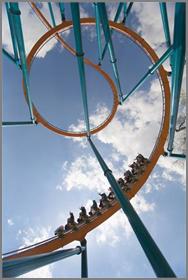
The amended Plan of Reorganization, filed on December 18, 2009, is based on a midpoint enterprise value of $1.4 billion. The Plan includes the issuance of $450 million of new equity pursuant to a Rights Offering supported by a fully-committed backstop and an additional $150 million delayed draw financing commitment from Time Warner to mitigate the risks posed by the annual Partnership Parks put obligations. From an ongoing operational perspective, the business plan continues the successful operational strategies adopted and implemented by current management. In addition, the Plan has the support of an informal committee of SFO bondholders, the Steering Committee of holders of Prepetition Credit Agreement Claims, and Time Warner, a key stakeholder and the provider of long term intellectual property rights to the Company.
Valuation
Houlihan Lokey, the Company’s financial advisors, has advised Six Flags with respect to the reorganization value of the Company on a going concern basis post-reorganization. The estimated range of reorganization value of Six Flags was derived by separately valuing SFTP and the partnership interests in the Partnership Parks held indirectly by SFI (each assuming a sum-of-the-parts analysis). Solely for purposes of the Plan, the estimated range of reorganization value for Six Flags was assumed to be approximately $1.25 billion to $1.55 billion (with a midpoint value of approximately $1.40 billion). The table below summarizes the components of the estimated range of reorganization value for Six Flags.
Estimated Range of Reorganization Value ($ billions)
|
|
|
Low |
|
Midpoint |
|
High |
|
|||
|
Enterprise Value SFTP |
|
$ |
1.21 |
|
$ |
1.35 |
|
$ |
1.49 |
|
|
Equity Value Partnership Parks |
|
0.04 |
|
0.05 |
|
0.06 |
|
|||
|
Estimated Total Enterprise Value |
|
$ |
1.25 |
|
$ |
1.40 |
|
$ |
1.55 |
|
Rights Offering
Along with the $680 million Exit Term Loan, holders of Prepetition Credit Agreement Claims will be paid in full in cash from the proceeds of the $450 million Rights Offering. The Rights Offering will be based on a $1.335 billion total enterprise value of Six Flags (as compared to the $1.4 billion midpoint of the POR valuation range). SFO bondholders that are accredited investors and vote to accept the Plan will be offered their limited pro rata share of the shares offered in the Rights Offering, for up to 25% of the $450 million Rights Offering. A subset of SFO Bondholders (the “Backstop Purchasers”) will purchase the remaining amount of the Rights Offering, plus any shortfall of the 25% offered to all SFO Bondholders. The new common stock offered in the Rights Offering will comprise 69.8% of the common stock of the reorganized Six Flags (subject to dilution in connection with awards under the Long-Term Incentive Plan).
CONFIDENTIAL
Pre-petition loan and bond treatment under the Plan ($ millions)
|
Class |
|
Claim |
|
Recovery |
|
Treatment |
|
|
SFTP |
|
$ |
1,147 |
|
100% |
|
· Paid in full in cash through proceeds of Exit Term Loan and Rights Offering |
|
|
|
|
|
|
|
|
|
|
SFO |
|
$ |
420 |
|
29.7%-45.5%(1) |
|
· To receive approximately 22.9% of the pro forma equity · Subject to dilution by the Long-Term Incentive Plan · Each accepting claimholder shall have the right to participate in the Rights Offering for its limited pro rata share · $450 million · Approximately 69.8% of pro forma equity · Subject to dilution by the Long-Term Incentive Plan |
|
|
|
|
|
|
|
|
|
|
SFI |
|
$ |
1,346 |
|
3.0%-4.7%(1) |
|
· To receive approximately 7.3% of the pro forma equity · Subject to dilution by the Long-Term Incentive Plan |
SFTP Prepetition Credit Agreement Claims
Under the Plan, the holders of Prepetition Credit Agreement Claims against SFTP and certain of its wholly-owned domestic subsidiaries will be paid in full in cash through the proceeds of the Exit Term Loan in the principal amount of $680 million and the Rights Offering in the principal amount of $450 million.
SFO Bondholders
SFO bondholders will convert their claims against SFO into approximately 22.9% of the new common stock to be issued by reorganized SFI (subject to dilution by the Long-Term Incentive Plan). Additionally, all accepting SFO unsecured claimholders who are accredited investors shall have the right to participate in the Rights Offering to purchase its limited pro rata share of up to $450 million of new common stock, representing 69.8% of the new common stock to be issued by SFI.
SFI Bondholders
The SFI bondholders will convert their claims against SFI into approximately 7.3% of the new common stock (also shared by SFO bondholders based upon SFI guaranty of SFO unsecured bonds) to be issued by reorganized SFI (subject to dilution by the Long-Term Incentive Plan) as well as the SFO guaranty claim
Existing Equity

All existing equity interests in SFI will be cancelled under the Plan. All existing equity interests in SFI’s direct subsidiary SFO will be cancelled, and 100% of the newly-issued common stock of SFO will be issued to SFI on the date of emergence in consideration of SFI’s distribution of the new common stock in reorganized SFI to certain creditors, as described above.
Partnership Parks, Subordinated Indemnity and Existing Time Warner Loan Guarantees
The SFTP, SFO and SFI guarantees of certain obligations to Time Warner under the Partnership Parks Agreement and Existing TW Loan will be discharged and exchanged for new guarantees of such
(1) Reflects lower equity value than the Disclosure Statement due to increased term loan amount
CONFIDENTIAL
obligations. The SFTP, SFO and SFI guarantees of certain obligations to Time Warner under the Subordinated Indemnity Agreement will be reinstated.
Equity Distributions under the Plan
|
Class |
|
% of New Equity Ownership(1) |
|
SFO Bondholders |
|
· 22.9% |
|
Rights Offering |
|
· 69.8% |
|
SFI Bondholders |
|
· 7.3% |
(1) All ownership percentages shown prior to dilution by the Long-Term Incentive Plan
Postconfirmation governance
Postconfirmation Board
The postconfirmation board will be comprised of nine directors, one of whom will be the CEO of reorganized SFI. The initial directors will be selected by a majority of the Backstop Purchasers, with a majority of the members of the board being independent. The Backstop Purchasers have agreed to consider certain directors of the current board identified by the CEO of reorganized SFI for selection to the postconfirmation board. All of the directors of reorganized SFI will stand for election annually.
Long-Term Incentive Plan
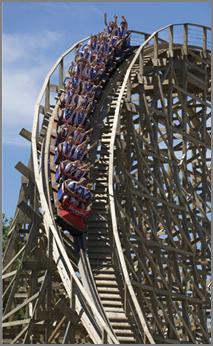
As of the Effective Date, Six Flags will implement an incentive based compensation program available for management, selected employees and directors of reorganized Six Flags (the “Long-Term Incentive Plan”). The Long-Term Incentive Plan will provide compensation in the form of stock options and/or restricted stock. The aggregate amount of stock to be issued under the program is 10% of the new common stock on a fully diluted basis. As of the Effective Date, allocations to senior management will consist of 3.75% of the new common stock, in the form of restricted stock, which will vest in annual installments over a four-year period, commencing on April 1, 2009(1). In addition, 3.75% of the new common stock will be issued to senior management in the form of options with an exercise price based on a $1.335 billion enterprise value (the same valuation under the backstop of the Rights Offering). These options will only vest at the expiration of the four-year vesting period of the restricted stock mentioned above. The remaining 2.5% available for distribution under the Long-Term Incentive Plan shall be allocated in a manner determined by the postconfirmation board.
Industry overview
Theme parks and amusement parks traditionally feature themed attractions and “thrill rides” set in family-friendly environments. The market is broadly divided into destination and regional parks. Regional theme parks draw most of their visitors from local markets, whereas destination parks draw visitors from national and international locales. The worldwide theme and amusement park market was estimated to be $24.1 billion in 2007, with the U.S. market estimated at $12.0 billion.
Most theme park operators focus on either the destination or regional market, although there are exceptions. Six Flags
(1) April 1, 2009 is the effective date of the employment agreements related to senior management
CONFIDENTIAL
is one of two major pure-play regional theme park operators in North America. In 2008, Six Flags was the #1 regional theme park operator by attendance, and trailed only The Walt Disney Company (“Disney”) among all U.S.-based operators. Busch Entertainment Corp. (“Busch Entertainment”, now known as “Seaworld Parks and Entertainment” or “Seaworld”), which was a division of Anheuser-Busch InBev (“AB InBev”) until December 2009, ranked #3. Although Seaworld operates a few regional parks, it derives the majority of its revenue from destination parks and is not traditionally considered a regional theme park operator. The other pure-play regional theme park operator is Cedar Fair L.P. (“Cedar Fair”), which ranked #4 in attendance among all U.S.-based operators in 2008.(1) Disney and Universal Orlando Resort (“UO”) only operate destination parks catering to national and international tourists.
The theme and amusement park space has attracted significant investment activity in recent years. Most recently, The Blackstone Group (“Blackstone”) announced in October 2009 that it would acquire Busch Entertainment from AB InBev for $2.3 billion in cash plus up to an additional $400 million based on Blackstone’s return on investment. This transaction closed in December 2009. Apollo Global Management (“Apollo”) announced in December 2009 that it would acquire Cedar Fair for $2.4 billion in cash. The transaction has yet to close.
Partnership Parks overview
The Company currently manages and owns beneficial interests in the Partnership Parks, which consist of Six Flags Over Texas (“SFOT”), Six Flags Over Georgia and Six Flags White Water Atlanta, collectively (“SFOG”). Indirect subsidiaries of SFI are the general partners of the Partnership Parks, and separate entities indirectly owned by Time Warner own substantial limited partnership (“LP”) stakes in SFOG and SFOT. Time Warner has assigned all cash flows and voting rights associated with the LP stakes to GP Holdings Inc., a subsidiary of SFI, so long as no default under the Partnership Parks Agreements exist. Currently, the Six Flags’ ownership percentage of the LP interests in SFOG and SFOT are 29% and 52%, respectively.

As part of the Partnership Park Agreements, SFO and SFTP guarantee certain obligations of the Partnership Parks, including a fixed annual preferred distribution to LP unitholders, a minimum level of capital expenditure spending on the parks, and the purchase of puts exercisable annually by LP unitholders. The total amount of potential puts outstanding is $356 million, of which $308 million are exercisable in 2010.
Time Warner financing
To help mitigate the uncertainty of funding of potential future puts, the Acquisition Parties have received a financing commitment from Time Warner for a new $150 million delayed-draw term loan (the “New TW Loan”) to finance future puts exercised by third party holders of LP units in the entities which own the Partnership Parks. Under the terms of the financing commitment, in future years, Six Flags will be obligated to fund put amounts up to a threshold of $10 million in 2010, $12.5 million in 2011, and $15 million in any year thereafter, with proceeds from the New TW Loan funding any put payment obligations in excess of such threshold amount, up to an aggregate $150 million.
The New TW Loan provides certainty and stability to the Six Flags capital structure, particularly in an area over which it historically had no control, and is a key component of the Plan. For the first time since the acquisition of these Partnership Parks in 1998, the New TW Loan gives the Company a dedicated source of funds to meet its Partnership Park put obligations.
(1) Source: TEA / ERA 2008 Attraction Attendance Report
CONFIDENTIAL
Historical financial summary
Summary financials ($ millions)
|
|
|
2006 |
|
2007 |
|
2008 |
|
2009P |
|
2009PCA(1),(2) |
|
|||||
|
Ticket revenue |
|
$ |
522.7 |
|
$ |
524.2 |
|
$ |
534.8 |
|
$ |
486.0 |
|
$ |
486.0 |
|
|
In-Park revenue |
|
393.8 |
|
408.0 |
|
427.5 |
|
381.9 |
|
381.9 |
|
|||||
|
Sponsorship, Licensing & Other |
|
25.7 |
|
38.6 |
|
59.0 |
|
42.2 |
|
42.2 |
|
|||||
|
Total revenue |
|
$ |
942.2 |
|
$ |
970.8 |
|
$ |
1,021.3 |
|
$ |
910.2 |
|
$ |
910.2 |
|
|
Cost of sales |
|
(80.0 |
) |
(81.5 |
) |
(86.4 |
) |
(77.1 |
) |
(77.1 |
) |
|||||
|
Gross profit |
|
$ |
862.2 |
|
$ |
889.3 |
|
$ |
934.9 |
|
$ |
833.1 |
|
$ |
833.1 |
|
|
Gross margin % |
|
91.5 |
% |
91.6 |
% |
91.5 |
% |
91.5 |
% |
91.5 |
% |
|||||
|
Cash operating expenses(3),(4) |
|
(623.0 |
) |
(661.5 |
) |
(627.4 |
) |
(619.9 |
) |
(603.9 |
) |
|||||
|
As % of revenues |
|
66.1 |
% |
68.1 |
% |
61.4 |
% |
68.1 |
% |
66.3 |
% |
|||||
|
Modified EBITDA(4) |
|
$ |
239.2 |
|
$ |
227.8 |
|
$ |
307.5 |
|
$ |
213.1 |
|
$ |
229.1 |
|
|
Modified EBITDA margin |
|
25.4 |
% |
23.5 |
% |
30.1 |
% |
23.4 |
% |
25.2 |
% |
|||||
|
Min int in earnings - EBITDA |
|
(44.4 |
) |
(38.2 |
) |
(32.2 |
) |
(23.1 |
) |
(23.1 |
) |
|||||
|
Adjusted EBITDA(4) |
|
$ |
194.8 |
|
$ |
189.6 |
|
$ |
275.3 |
|
$ |
190.0 |
|
$ |
206.0 |
|
|
|
|
|
|
|
|
|
|
|
|
|
|
|||||
|
Cash interest (Net) |
|
(187.6 |
) |
(196.5 |
) |
(157.5 |
) |
(82.9 |
) |
(50.0 |
) |
|||||
|
Capital expenditures (Net) |
|
(101.1 |
) |
(114.1 |
) |
(90.3 |
) |
(100.0 |
) |
(91.0 |
) |
|||||
|
PIERS cash dividends |
|
(20.8 |
) |
(20.8 |
) |
(5.2 |
) |
0.0 |
|
0.0 |
|
|||||
|
Cash paid for debt issuance costs |
|
(3.0 |
) |
(19.1 |
) |
(9.7 |
) |
0.0 |
|
0.0 |
|
|||||
|
Cash taxes |
|
(4.7 |
) |
(5.0 |
) |
(7.0 |
) |
(9.0 |
) |
(9.0 |
) |
|||||
|
Free Cash Flow(4) |
|
$ |
(122.4 |
) |
$ |
(166.0 |
) |
$ |
5.6 |
|
$ |
(1.9 |
) |
$ |
56.0 |
|
|
Cash flow from operating activities |
|
56.3 |
|
9.7 |
|
107.7 |
|
109.8 |
|
125.8 |
|
|||||
|
Cash flow from investing activities |
|
(40.0 |
) |
64.2 |
|
(93.7 |
) |
(85.9 |
) |
(76.9 |
) |
|||||
|
Cash flow from financing activities |
|
(72.4 |
) |
(70.1 |
) |
169.7 |
|
(64.5 |
) |
(64.5 |
) |
|||||
(1) Projected 2009 Cost Adjusted EBITDA of $206MM, which comprises the projected 2009 Adjusted EBITDA of $190MM and $16MM in additional cost savings projected for 2010 applied to such projected 2009 Adjusted EBITDA
(2) Projected 2009 Cost Adjusted Capital Expenditures (net) of $91MM, which comprises the projected 2009 Capital Expenditures (net) of $100MM and $9MM in additional capital expenditure reductions projected for 2010 applied to such projected 2009 Capital Expenditures (net)
(3) Excludes costs associated with the change of corporate management that occurred in late 2005 and early 2006 (approximately $13.9 million recognized as expense in 2006)
(4) As defined in the Appendix
CONFIDENTIAL
2009 Financial highlights
In the spring and early summer, several events combined to impact the Company’s operations. The swine flu virus epidemic had a significant impact on early season attendance, particularly at the parks located in Texas and Mexico. The Mexico City park was closed for two weeks during the peak of the crisis. The economic recession had a material impact on both attendance and in-park spending levels at parks throughout the country. The negative publicity from the Company’s impending bankruptcy filing as well as unusually inclement weather in the Northeast also contributed to lower attendance levels.
Attendance was approximately flat to the prior year in April; however, the factors noted above drove attendance declines through mid-July. Attendance was down by 1.1 million guests through July 19, 2009 compared to the previous year, with attendance trends stabilizing beginning in mid-July through the end of the peak operating season (Labor Day). Attendance was essentially flat compared to 2008 results during this period. However, unusually wet weather in the Northeast in October with rainfall on virtually every October weekend, which includes the popular Fright Fest product, further dampened results by another 450,000 guests compared to the prior year.
Set forth below is a comparison of YTD 2009 and 2008 actual cumulative attendance.
Cumulative attendance comparison April 2009 - November 2009
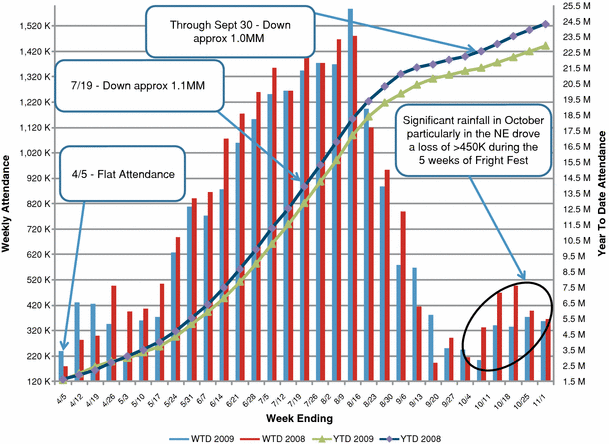
CONFIDENTIAL
2. Key investment considerations
Geographic diversity
Six Flags’ parks are located in geographically diverse markets across North America reaching 9 of the top 10 DMAs. No single park accounted for more than 13% of revenue or 18% of Modified EBITDA(1) in 2008.
High barriers to entry
High barriers to entry provide each of the Company’s parks with a significant degree of protection from competitive new theme park openings in their respective regions. While the Company’s parks benefit from limited direct theme park competition, a restricted supply of real estate appropriate for theme park development and zoning restrictions are two important barriers to entry. The high initial capital investment required to start a park and long development lead-time also contribute to protecting Six Flags from new direct theme park competition. Additionally, a significant financial commitment would be required to construct a new regional theme park comparable to one of the major Six Flags branded theme parks. The Company estimates it would require at least $300 million to construct a similar theme park, excluding the cost of land, and would take a minimum of two years to construct.
Valuable advertising platform
The Company’s high attendance levels from attractive demographic segments allow Six Flags to deliver a valuable advertising platform. With approximately 25 million guests in expected average annual attendance, Six Flags is attractive to both local and national advertisers. The Company’s annual attendance is higher than the league-wide seasonal attendance levels of several professional sports leagues, and provides advertisers an alternative, out-of-home advertising channel. Out-of-home advertising is becoming an increasingly popular type of advertising and few venues offer the geographic and population reach that Six Flags offers. As the chart below highlights, the length of stay is another significant differentiator for Six Flags, where the expected average length of stay is 8.6 hours as opposed to 2.7 hours for the NBA and NHL, and 3.1 hours for the NFL. This longer average time-of-visit translates into a broad and captive audience for up to 10 hours per visit (3x — 4x the average sports event), with a focus on families and young adults. Over 75% of Six Flags’ annual attendance resides within 100 miles of the parks, making them an ideal value for local advertisers. Additionally, the Company’s national platform and its presence in nine of the top ten DMAs in the United States appeals to national and regional accounts. Moreover, the Company continues to develop ways to leverage this captive audience and increase advertising revenue, such as Six Flags Television (SFTV) monitors in ride lines and video display boards at its restaurants.
(1) As defined in the Appendix
CONFIDENTIAL
Six Flags advertising demographics
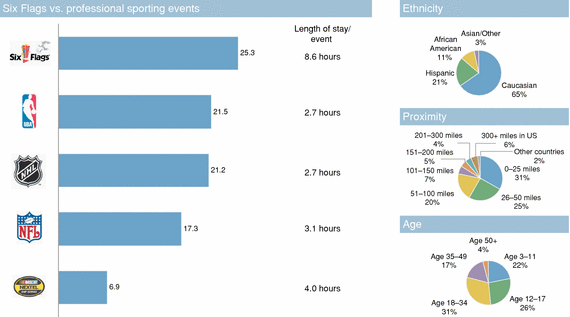
Source: Elias Sports research,
league websites, and Nielsen (attendance in millions): 2008-2009 Season: NFL,
NBA, NHL
2007 Season NASCAR
Demographic source: 2009 ATS Survey
Sponsorship revenue opportunities
With approximately 25 million guests per year, Six Flags provides a strong platform for future sponsorship opportunities to reach a broad captive audience. As a result, Six Flags has increased sponsorship, licensing and other fees from approximately $16 million under contract at the time new management was installed in late 2005 and early 2006 to approximately $59 million for 2008. In 2009, the Company held over 40 national and regional deals and over 320 local park-specific partnerships, with brands such as Johnny Rockets, Papa John’s pizza, Coca Cola, and many others. These relationships typically include annual sponsorship fees, direct marketing opportunities and provide multiple marketing touch points for Six Flags. Additionally, the Company improves its reputation by associating itself with high quality brands.
Six Flags’ ability to rapidly identify and effectively capitalize on sponsorship opportunities is a part of the significant growth in gross revenue per capita and gross profit per capita. For example, replacing unbranded pizza in 2006 with Papa John’s, a newly-acquired national sponsor, increased gross revenue per capita spending on pizza by 93% and increased gross profit per capita on pizza by 87% by 2008. Similarly, replacing unbranded hamburgers with Johnny Rockets increased gross revenue per capita spending on hamburgers by 42% and increased gross profit per capita on hamburgers by 30% by 2008.
CONFIDENTIAL
Six Flags brand partnerships
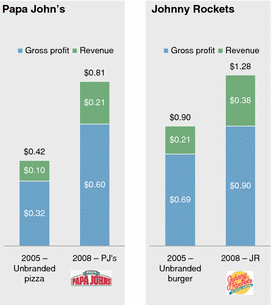
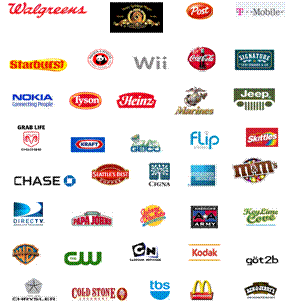
Attractive IP portfolio
Six Flags’ attractive IP portfolio and long-term licensing contracts help increase customer satisfaction and differentiate the Company from other leisure time activities. Six Flags holds exclusive long-term licenses for theme park usage throughout the United States (excluding the Las Vegas metropolitan area), Canada, and Mexico for certain Warner Bros. and DC Comics characters.

The Company also holds the rights to use other popular characters such as The Wiggles, Scooby Doo, Yogi Bear, Thomas the Tank Engine and The Flintstones in its parks.

The Company believes the presence of well-known characters in the parks drives higher revenue, an improved guest experience and more frequent visitation. Its ability to use and market its licensed characters provides Six Flags with a competitive advantage relative to the other local entertainment options, and helps attract more families to the parks.
According to a 2009 guest satisfaction survey, guests who saw costumed characters were more likely to purchase gifts or souvenirs, play skill games and have pictures taken or purchase photos.
CONFIDENTIAL
Proportion of guests participation

Source: 2009 Guest Satisfaction Survey
In addition, guests who saw costumed characters were significantly more likely to rate “Value for the Money” and “Overall Experience” a “10” versus those not seeing characters. Guests who did not recall seeing costumed characters, instead, were significantly more likely to rate “Value for the Money” a “6 or below.”
|
Value for the Money |
|
Overall Experience |
|
|
|
|
|
|
|
|
Source: 2009 Guest Satisfaction Survey
CONFIDENTIAL
Well-invested portfolio of state of the art rides

In prior years, before the current management team joined Six Flags, the Company invested heavily in state of the art roller coasters and thrill rides, spending well above free cash flow levels and financing these investments with debt. Over time, this pattern resulted in an over levered capital structure and ultimately resulted in the current reorganization. The current management team has been much more disciplined in its capital spending and will continue this strategy. However, these historical investments have built one of the most sophisticated and technically advanced portfolios of roller coasters in the world. Six Flags’ state of the art rides consistently rank among the most popular in the world. These renowned rides have given Six Flags a reputation for great rides, and have provided management with strong products to market, helping drive attendance, in-park spending, and sponsorship revenue.
Six Flags remains committed to maintaining its portfolio of state of the art rides. The Company offers more than 800 rides, including over 120 roller coasters, has invested over $1.0 billion in its parks since 2000, and projects to invest $80 million to $100 million annually into its parks.

Top Rides in North America
|
Ride |
|
Park |
|
Rank |
|
Steel |
|
|
|
|
|
Bizarro |
|
Six Flags New England |
|
#1 |
|
Nitro |
|
Six Flags Great Adventure |
|
#3 |
|
Goliath |
|
Six Flags Over Georgia |
|
#4 |
|
X2 |
|
Six Flags Magic Mountain |
|
#13 |
|
Raging Bull |
|
Six Flags Great America |
|
#14 |
|
Mind Bender |
|
Six Flags Over Georgia |
|
#16 |
|
Kingda Ka |
|
Six Flags Great Adventure |
|
#31 |
|
Tatsu |
|
Six Flags Magic Mountain |
|
#32 |
|
Goliath |
|
Six Flags Magic Mountain |
|
#33 |
|
Shock Wave |
|
Six Flags Over Texas |
|
#34 |
|
Superman Ride of Steel |
|
Six Flags America |
|
#35 |
|
Titan |
|
Six Flags Over Texas |
|
#37 |
|
Superman Krypton |
|
Six Flags Fiesta Texas |
|
#44 |
|
Whizzer |
|
Six Flags Great America |
|
#47 |
|
|
|
|
|
|
|
Wooden |
|
|
|
|
|
El Toro |
|
Six Flags Great Adventure |
|
#3 |
|
Evel Knievel |
|
Six Flags St. Louis |
|
#13 |
|
Viper |
|
Six Flags Great America |
|
#30 |
|
Texas Giant |
|
Six Flags Over Texas |
|
#32 |
|
The Boss |
|
Six Flags St. Louis |
|
#33 |
|
Screamin’ Eagle |
|
Six Flags St. Louis |
|
#40 |
|
Terminator Salvation |
|
Six Flags Magic Mountain |
|
#43 |
|
Georgia Cyclone |
|
Six Flags Over Georgia |
|
#44 |
Source: Rankings based on Amusement Today’s 2009 Golden Ticket Awards
CONFIDENTIAL
Favorable industry characteristics

Six Flags benefits from several favorable industry characteristics. First, there is limited direct theme park competition within local markets. Second, most of the Company’s guests reside close to the parks’ locations, as 78% of attendance resides within 100 miles of the parks. Third, regional parks are typically better positioned than destination parks during a downturn and present an affordable alternative to an out-of town family vacation. Finally, a Six Flags season pass offers multiple visits for a single price, presenting a compelling value proposition.
Well-balanced capital structure
Upon emergence, Six Flags will be appropriately capitalized with lower leverage than many of its peer companies. The bankruptcy process will shed $1.7 billion of debt from the balance sheet, enabling the Company to maintain liquidity, improve Free Cash Flow(1), and foster future growth opportunities.
Total Leverage(1)
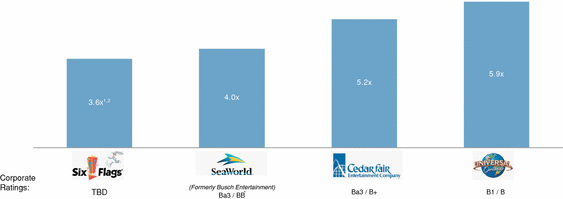
Source: Rating Agency websites, public filings and news reports
Seaworld (formerly Busch Entertainment): LCD, pro forma for December 2009
divestiture; Cedar Fair: Public filings; based on LTM EBITDA 9/30/09; debt levels pro forma for December 2009
transaction; Universal Orlando: Offering Memorandum, LTM EBITDA, debt levels
pro forma for October 2009 notes issuance
(1) Based on Projected 2009 Cost Adjusted EBITDA of $206 million, which is comprised of the projected 2009 Adjusted EBITDA of $190 million and $16 million in additional cost savings projected for 2010 applied to such projected 2009 Adjusted EBITDA
(2) Leverage calculated based on year-one average RC drawn amount of $29mm
Strong collateral coverage
The Company’s Prepetition Credit Agreement Facility is secured by substantially all assets of SFTP’s domestic wholly-owned subsidiaries as well as 100% of the stock of SFTP’s domestic wholly-owned subsidiaries and 65% of the stock of foreign subsidiaries. The real estate of most domestic parks is owned by the Company, and many of the parks are well situated in the largest markets in North America.
Collateral coverage ($billions)
|
|
|
Book Value |
|
Plan Valuation |
|
||
|
Tangible Asset Value |
|
$ |
1.55 |
(1) |
$ |
1.35 |
(2) |
|
Total Pro Forma Debt(3) |
|
0.75 |
|
0.75 |
|
||
|
Collateral Coverage |
|
2.1x |
|
1.8x |
|
||
(1) Six Flags consolidating balance sheet as of May 2009, SFTP only (excludes SFI tangible asset value)
(2) Excludes Equity Value of Partnership Parks (with a midpoint Equity Value of approximately $49.5 million per Disclosure Statement)
(3) Calculated based on year-one average RC drawn amount of $29mm
(1) As defined in the Appendix
CONFIDENTIAL
Proven management team
In late 2005 and early 2006, the new Board of Directors installed a new management team led by Mark Shapiro (CEO) and Jeffrey Speed (CFO) that effectuated the Company’s financial and operational turnaround. The management team brought strong prior experience to Six Flags. Prior to serving as President, Chief Executive Officer and a Director of Six Flags since December 2005, Mr. Shapiro had been the Executive Vice President, Programming and Production of ESPN, Inc. Mr. Speed brought a broad-based financial background and extensive experience in the media, entertainment, and theme park industries, most recently from his service as Senior Vice President and Chief Financial Officer of Euro Disney.
In addition to Mr. Shapiro and Mr. Speed, the Six Flags management team driving the Company’s recent turnaround is rounded out by a group qualified professionals whose roles and achievements are detailed below:
Mark Quenzel joined Six Flags following 15 years with ESPN, where he served as Senior Vice President of Programming and Production. He oversees all park operations, strategy, and safety for the Six Flags parks. Michael Antinoro served as the Executive Producer of ESPN Original Entertainment (EOE), the core creative group that led the ESPN brand into non-traditional sports and entertainment programming. He oversees all aspects of Six Flags’ advertising, promotions, entertainment, marketing and communications. Louis Koskovolis joined Six Flags from his position as Executive Vice President of Multi-Media Sales for ESPN and ABC Sports. He oversees the Corporate Alliances group which focuses on developing key national, regional and local sponsorships for all Six Flags’ parks and creates cross-promotional platforms. Andrew Schleimer joined Six Flags from UBS Investment Bank, where he served as Vice President in the bank’s Mergers and Acquisitions department. He oversees Six Flags’ Strategic Development and In-Park Services, a division that focuses on increasing company revenue and enhancing the park experience through agreements with branded food, beverage, equipment, service and retail partners. James Coughlin practiced law at several private law firms, most recently at the former Baer Marks & Upham firm in New York City and has served as the Company’s General Counsel since 1998.
Recent operational improvements position the Company for growth
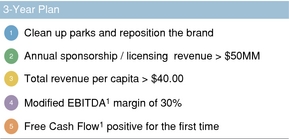
Once installed, the current management team set out five key objectives, all of which were accomplished by the end of its third year, 2008. First, the team repositioned the brand by diversifying the product offering and cleaning up and improving the parks. This repositioning resulted in key guest satisfaction scores at or above all-time highs. Second, the team developed and grew new high margin opportunities for the Company, increasing annual sponsorship and licensing revenues to over $59 million in 2008. Third, the Company achieved total revenue per capita of over $40.00, representing a 20.0% cumulative growth from 2005. Fourth, the Company improved its margins, operating at a Modified EBITDA(1) margin of over 30% in 2008, with a Modified EBITDA(1) of $307.5 million for the year ended December 31, 2008. Finally, the Company successfully became Free Cash Flow(1) positive in 2008 for the first time in the Company’s history.
2006 — 2007
The Company was able to increase total revenue per capita by focusing on improving the guest experience, customer service, and appearance and cleanliness of the parks. Management
(1) As defined in the Appendix
CONFIDENTIAL
worked to successfully build a corporate alliance team, as Six Flags partnered with well known brand names such as Papa John’s and Cold Stone Creamery. Corporate alliances and the conversion to branded concepts became a revenue and EBITDA driver for the Company.
2007 — 2008
Six Flags implemented a plan designed to broaden family offerings. The Company also launched staffing initiatives to improve recruiting, training, retention and efficiency. Six Flags built upon its corporate alliances, partnering with additional well known brand names such as Johnny Rockets and Kodak. The Company invested in IT infrastructure designed to improve systems, ticketing, point of sale and its website. This investment in IT infrastructure also generated new revenue streams with Six Flags TV and Radio.
2008
The Company implemented a more efficient and targeted marketing plan with an online focus. This program concentrated advertising spending in the early portion of the season. Six Flags also launched an attraction program with 7 coasters for 7 parks. The Company reduced operating expenses, while expanding its 2007 staffing initiatives and decreasing full time employees. Six Flags increased guest spending and total revenue per capita through additional sponsorship and international licensing opportunities. Additionally, several inefficient attractions were removed.
The table below illustrates the improvements management has been able to achieve since coming on board in late 2005 and early 2006, highlighting the operating milestones that management set out to accomplish in its three year plan:
Operating milestones ($ millions)
|
|
|
2005 |
|
2006 |
|
2007 |
|
2008 |
|
||||
|
Attendance (million) |
|
28.2 |
|
24.8 |
|
24.9 |
|
25.3 |
|
||||
|
Total Revenue per Cap |
|
$ |
33.44 |
|
$ |
37.93 |
|
$ |
38.99 |
|
$ |
40.30 |
|
|
Revenue |
|
$ |
943 |
|
$ |
942 |
|
$ |
971 |
|
$ |
1,021 |
|
|
Sponsor / License Revenue |
|
$ |
20 |
|
$ |
26 |
|
$ |
39 |
|
$ |
59 |
|
|
Modified EBITDA(1),(2) |
|
$ |
306 |
|
$ |
239 |
|
$ |
228 |
|
$ |
307 |
|
|
Modified EBITDA Margin (1),(2) |
|
32.5 |
% |
25.4 |
% |
23.5 |
% |
30.1 |
% |
||||
|
Adjusted EBITDA(1),(2) |
|
$ |
261 |
|
$ |
195 |
|
$ |
190 |
|
$ |
275 |
|
|
Capex (Net) |
|
$ |
160 |
|
$ |
101 |
|
$ |
114 |
|
$ |
90 |
|
|
Free Cash Flow(1),(2) |
|
$ |
(111 |
) |
$ |
(122 |
) |
$ |
(166 |
) |
$ |
6 |
|
|
Cash flow from operating activities |
|
165.8 |
|
56.3 |
|
9.7 |
|
107.7 |
|
||||
|
Cash flow from investing activities |
|
(37.1 |
) |
(40.0 |
) |
64.2 |
|
(93.7 |
) |
||||
|
Cash flow from financing activities |
|
(116.7 |
) |
(72.4 |
) |
(70.1 |
) |
169.7 |
|
||||
(1) As defined in the Appendix
(2) Modified EBITDA, Adjusted EBITDA and Free Cash Flow exclude costs of the change of corporate management that occurred in late 2005 and early 2006 (approximately $12.6 million and $13.9 million recognized as expense in 2005 and 2006, respectively).
CONFIDENTIAL
3. Partnership Parks overview
Partnership Parks Agreements
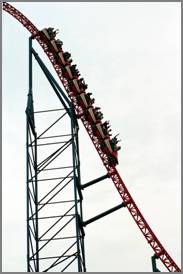
SFO and SFTP have guaranteed certain obligations of the parks including the following:
(i) minimum preferred return and ground lease payment to limited partners. The fixed annual distributions to LPs (including ground lease payments) grow at the rate of the Consumer Price Index. The amount of the distribution was $60.7 million in 2009. The distribution currently represents an approximate 9.7% yield to the LP investors on their original tender offer price.
(ii) minimum capital expenditure requirements. The minimum capital expenditures requirement requires the Company to fund 6% of the average Partnership Parks revenues as capital over rolling 5-year periods.
(iii) annual offer to purchase limited partnership units that are put to the Company by LP unit holders. The maximum amount of puts that can be exercised in any year is 5%, and any unused amounts accrue to subsequent years. These obligations continue until 2027 and 2028 for the Georgia and Texas parks, respectively. The aggregate potential amount of puts outstanding following the May 2009 puts is $356 million. The amount of puts exercisable in April 2010 is $308 million.
The price of a Partnership Park put is set at park valuations set forth below:
|
· |
Georgia — greater of: |
|
· |
Texas: — greater of : |
|
|
(i) 8.0x trailing 4 yr average EBITDA and |
|
|
(i) 8.5x trailing 4 yr average EBITDA and |
|
|
(ii) $250 million |
|
|
(ii) $375 million |
The level of puts has averaged approximately $3 million annually, with the notable exception of 2009, when the put amount was $66 million.
In 2027 SFOG and 2028 SFOT, the Company has a call option on all remaining units outstanding at set prices.
In addition SFI, SFO, SFTP and the domestic subsidiaries of SFTP have indemnified Time Warner pursuant to the Subordinated Indemnity Agreement (as described below) with respect to any amounts paid by Time Warner pursuant to its guarantee of obligations under the Partnership Parks Agreements.
Six Flags funds certain of these obligations via unsecured affiliate loans from the general partner of the Partnership Parks (an indirect subsidiary of SFI) to the Partnership Parks. Such loans are subordinated to the Partnership Parks’ obligation to fund the preferred return. In the event of a default by Six Flags under the Subordinated Indemnity Agreement, Time Warner is entitled to take control of the corporate parent of the general partners and thus, in effect, become the holder of the affiliate loans.
CONFIDENTIAL
Partnership Parks financing structure
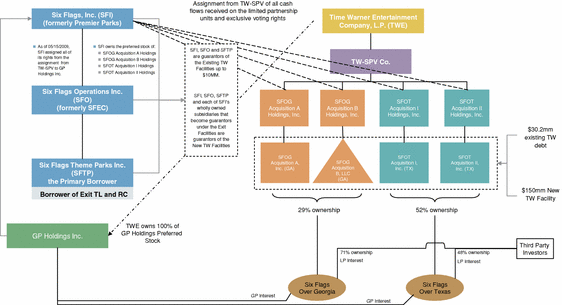
Subordinated Indemnity Agreement
Time Warner guarantees all the obligations of the Six Flags entities under the Partnership Parks arrangements. Pursuant to an agreement between Time Warner and Six Flags (the “Subordinated Indemnity Agreement”), SFI, SFO, SFTP and the domestic subsidiaries of SFTP have indemnified Time Warner for any losses incurred with respect to these guarantees. In the event of a failure by Six Flags to perform under this agreement, Time Warner would be able to acquire all of Six Flags’ ownership of LP units (including the right to receive any cash flow therefrom), and replace Six Flags as the general partner of the Partnership Parks. In this situation, the parks would be permitted to continue to use the Six Flags brand to operate. A failure to perform under the agreement would also serve as a default under Time Warner’s overall license agreement with Six Flags, which could result in the revocation of Six Flags’ ability to use Time Warner’s intellectual property in its parks.
2009 Liquidity Puts
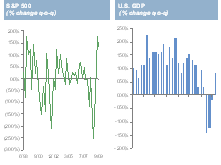
The Partnership Parks put amounts had been immaterial prior to 2009, averaging approximately $3 million per year (see diagram below). In 2009, however, the Company witnessed approximately $66 million of puts exercised by the LP investors, primarily related to the Texas partnership. A potential factor that may have contributed to the high level of puts in 2009 was a statement by the general partner of the Texas partnership, who manages the partnership that holds SFOT LP units. The general partner has a right of first refusal to purchase up to 50% of any puts exercised in any year, and historically has purchased his full share. However, in early 2009 the general partner issued a letter to the LP’s stating that he would not be purchasing his share of puts in 2009, and that he was likely to put part of his own interests. His reasoning for the decision was undisclosed. (The general partner of the Georgia partnership exercised his right to purchase 50% of the Georgia units put in 2009.) Additionally, the unprecedented level of puts in 2009 may have been driven by investors seeking additional liquidity in the midst of the credit crisis as well as general concerns about a potential Six Flags bankruptcy filing.
CONFIDENTIAL
Historic Puts since 1998 acquisition

To meet the $66 million put obligations of 2009, funding was provided as follows: i) $7 million from the general partner of SFOG to exercise his purchase right for a portion of the puts at SFOG, ii) $6 million of funding was provided from an escrow account for Time Warner’s benefit, and iii) $53 million from a Time Warner subsidiary loan (the “Existing TW Loan”). The Company has repaid approximately $23 million of the Existing TW loan through its share of the Partnership Parks’ distribution in 2009. The remaining $30 million will remain as an obligation to the Acquisition Parties and will be repaid through the Company’s portion of the annual LP distribution.
The New Time Warner Loan
To help mitigate the risks of potential future puts, the Acquisition Parties have received a financing commitment from Time Warner for the New TW Loan to finance future puts exercised by third party holders of limited partnership units in the entities which own the Partnership Parks.
The New TW Loan provides certainty and stability to the Six Flags capital structure, particularly in an area over which it historically had no control, and is a key component of the Plan. For the first time since the acquisition of these Partnership Parks in 1998, the New TW Loan gives the Company a dedicated source of funds to meet its Partnership Park put obligations, resulting in the only source of external funding the Company has ever had around this contingent obligation.
The pricing and terms of the New TW Loan are set forth below:
New Time Warner Loan
Summary of terms and conditions
|
Lender: |
|
TW-SF LLC or any other affiliate of Time Warner Inc. |
|
Borrowers: |
|
SFOG Acquisition A, Inc.; SFOG Acquisition B, LLC; SFOT Acquisition I, Inc.; and SFOT Acquisition II Inc. (joint and several borrowers) |
|
Guarantors: |
|
SFI, SFO, SFTP, and each subsidiary of SFI who are or in the future become guarantors under the Exit Facilities |
|
Commitment: |
|
$150 million; The facility amount will be permanently reduced on a dollar-for-dollar basis to the extent of each draw under the facility |
|
Availability: |
|
· Available to be drawn for 5 years after closing · Available to fund puts exercised by LP unit holders above $10 million in 2010, $12.5 million in 2011, and $15 million thereafter · Available to be drawn on May 14th of each year |
|
Interest rate: |
|
L+525 bps (spread is 1% higher than Exit Facility debt) |
|
LIBOR floor: |
|
2.5% |
|
Term: |
|
Five years from each funding |
|
Amortization: |
|
100% of SFI’s share of preferred distributions from partnership parks applied to pay down the loans |
|
Call protection: |
|
Prepayable at par |
Mandatory Prepayment Provision
The Existing TW Loan and New TW Loan each contain a mandatory prepayment provision which requires 100% of the proceeds received from Six Flags’ share of the Limited Partner preferred return distributions to be applied in the following sequence: 1) Existing TW Loan interest 2) Existing TW Loan principal 3) New TW Loan interest 4) New TW Loan principal. The Limited Partner preferred return is a fixed obligation every year that grows by the Consumer Price Index. While the Existing and New TW Loans are in place, SFI’s share of the annual distribution will be
CONFIDENTIAL
directed first to service interest and principal on the Time Warner loans before it can be used to fund expenses and capital requirements at the Partnership Parks. Consequently, Six Flags will be required to make up any cash flow shortfall at the Partnership Parks through affiliate loans from the general partners of the Partnership Parks (indirect subsidiaries of SFI) to the Partnership Parks. Once the Time Warner loans are repaid, Six Flags’ share of the distribution will become available to fund any cash flow shortfalls at the Partnership Parks, or any other obligations of SFI and its subsidiaries.
CONFIDENTIAL
4. Summary of terms and conditions
(Complete facilities Term Sheets have been posted to Intralinks for lender review)
CONFIDENTIAL
5. Form of commitment advice

Form of Commitment Advice
(Telecopy to Steve Lunau at 917-464-4197 or email to steven.c.lunau@jpmorgan.com)
|
J.P.
Morgan Securities Inc. |
|
Bank
of America Merrill Lynch |
|
Barclays
Capital |
|
Deutsche
Bank Securities |
Ladies and Gentlemen:
We refer to the Summary of Terms and Conditions for Six Flags Theme Parks Inc. (the “Borrower”) included in the Confidential Information Memorandum dated January 7, 2010. Subject only to satisfactory documentation, we are pleased to commit $ million to the Exit Revolving Credit facility and $ million to the Exit Term Loan. We understand that allocations will be made at the discretion of the Company and the Joint Bookrunners.
Our commitment is made solely on behalf of our institution and does not in any way include a commitment or other arrangement from any other non-affiliated institution. We agree that no secondary selling or offers to purchase will occur until the Joint Bookrunners declare the primary syndication to be complete.
Our decision to issue our commitment is based on our independent investigation of the financial condition, creditworthiness, affairs and the status of the Company without reliance upon any material or information furnished to us by the Joint Bookrunners or any of their affiliates, which material or information is hereby acknowledged by us to have been for informational purposes only without any representation or warranty by the Joint Bookrunners or their affiliates.
Very truly yours,
Authorized Officer:
Title:
Lender:
Telephone Number:
CONFIDENTIAL
6. Administrative questionnaire
(Administrative questionnaire has been posted separately to Intralinks)
CONFIDENTIAL
7. Business description

From the creation of the Six Flags brand in 1961 with one theme park in Arlington, Texas, to its expansion over the past 48 years, both throughout the United States and internationally, Six Flags has established its position as a leader in the amusement and theme park industries. Today, Six Flags is the largest regional theme park operator in the world. The 20 parks the Company operates had attendance of approximately 25.3 million during the 2008 season in geographically diverse markets across North America. Its theme parks offer a complete family-oriented entertainment experience along with a broad selection of state-of-the-art and traditional thrill rides, water attractions, themed areas, concerts and shows, restaurants, game venues and retail outlets. In the aggregate, during 2008 the Company’s theme parks offered more than 800 rides, including over 120 roller coasters, making it the leading provider of “thrill rides” in the industry.
From its headquarters in New York City, Six Flags operates parks throughout North America, and has entered into development agreements to extend its brand beyond North America. SFI, a publicly-traded corporation, is the ultimate parent of each of the other Six Flags entities. Six Flags conducts the majority of its business through SFO which, in turn, owns all of the capital stock of SFTP. SFTP owns, directly or through its subsidiaries, all of Six Flags’ parks other than the Partnership Parks. GP Holdings, Inc., through its subsidiaries, is the general partner of the partnerships that own portions of the Partnership Parks. The entities that own and operate both the Partnership Parks and the Company’s foreign parks were not part of the Company’s Chapter 11 filing.
Summary organizational chart
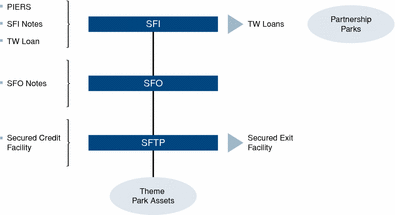
CONFIDENTIAL
Six Flags generates park revenue from three distinct sources: 1) admissions, 2) in-park food, merchandise and other revenue, and 3) sponsorship, licensing and other fees. Admissions represented 52% of Six Flags’ total revenue in 2008, while food, merchandise and other revenue represented 42% and sponsorship, licensing and other fees represented 6%.
Revenue breakdown

Ancillary lines of business
dick clark productions, inc. (“dcp”)
On June 18, 2007, Six Flags acquired an original 40% interest (subsequently reduced to 39.2%) in a venture that owns dcp for a net investment of approximately $39.7 million. The Company believes that its investment in dcp provides it with additional sponsorship and promotional opportunities. In addition, Six Flags receives an annual fee to manage dcp. Six Flags leverages the dcp library, which includes the Golden Globes, the American Music Awards, the Academy of Country Music Awards, So You Think You Can Dance, American Bandstand and Dick Clark’s New Year’s Rockin’ Eve, to provide additional product offerings in its parks. It uses this library within its parks through rewind and blooper shows on SFTV television programming, stage shows, sweepstakes and drawings for tickets to the awards shows.
Six Flags Great Escape Lodge & Indoor Waterpark (“HWP”)
Six Flags currently manages and owns a 41% interest in this hotel indoor-waterpark located in Lake George, New York, which is adjacent to the Company’s wholly-owned Great Escape theme park. HWP is a 200 room lodge featuring a 38,000 sq ft indoor water park offering entertainment, casual dining, meeting and conference centers and a day spa.
|
|
|
|
|
|
International licensing
International licensing provides Six Flags an opportunity for high-margin revenue growth that leverages its strong brand name and design, development, and operational expertise without requiring any commitment of capital. The international licensing and development deals include fees for the license and use of Six Flags’ intellectual property and for design and development services. Licensees are provided the exclusive use of marks and services in the respective territory. Throughout the term of the license they pay Six Flags a fixed fee payment. In addition, licensees are granted the on-going use of marks and services upon project opening, at which time Six Flags is entitled to royalty payments.
CONFIDENTIAL
Six Flags also provides concept, design, and development services including creation of a master plan, incorporating key aspects of the brand, creative consulting, conceptualization and attraction design.
Dubai licensing deal

In March 2008, Six Flags entered into an agreement with Tatweer Dubai LLC, a member of Dubai Holding (“Tatweer”), to create a Six Flags-branded theme park in Dubai, United Arab Emirates. Pursuant to the agreement, Six Flags is providing design and development services for the creation of the park, which will be operated and managed by Tatweer or one of its affiliates. Six Flags also granted Tatweer the exclusive right to use the Company’s brand in certain countries for certain time periods including the United Arab Emirates. As consideration for services rendered and for the exclusivity rights granted in the agreement, Six Flags will receive license and other fees over the design and development period plus an ongoing royalty fee once the park opens.
Theme Park Operations

Each of the Six Flags theme parks is managed by a park president who reports to a regional vice president or senior vice president in the Park Strategy and Management Group. The park president is responsible for all operations and management of the individual park. Local advertising, ticket sales, community relations and hiring and training of personnel are the responsibility of individual park management in coordination with corporate support teams.
Each park president also directs a full-time, on-site management team. Each management team includes senior personnel responsible for operations and maintenance, in-park food, beverage, merchandising and games, marketing and promotion, sponsorships, human resources and finance. Finance directors at Six Flags’ parks report to the Senior Vice President, Finance and Chief Accounting Officer, and with their support staff, provide financial services to their respective parks and park management teams. Park management compensation structures are designed to provide financial incentives for individual park managers to execute the Company’s strategy and to maximize revenues and free cash flow.
Six Flags’ parks are generally open daily from Memorial Day through Labor Day. In addition, most of the parks are open during weekends prior to and following their daily seasons. Due to their location, certain parks have longer operating seasons. Typically, the parks charge a basic daily admission price, which allows unlimited use of all rides and attractions, although in certain cases special rides and attractions require the payment of an additional fee.

Marketing and Promotional Activities
Six Flags attracts visitors through multi-media marketing and promotional programs for each of its parks. The national programs are designed to market and enhance the Six Flags brand name
CONFIDENTIAL
while the regional and local programs are tailored to address the different characteristics of their respective markets and to maximize the impact of specific park attractions and product introductions. All marketing and promotional programs are updated or completely changed each year to address new developments.
Six Flags frequently develops alliance, sponsorship and co-marketing relationships with well-known national, regional and local consumer goods companies and retailers to supplement its advertising efforts and to provide attendance incentives in the form of discounts and or premiums. Popular local radio and television programs are filmed and broadcasted live from the parks.

The Company offers discounts on season pass and multi-visit tickets, as well as tickets for specific dates and tickets to affiliated groups such as businesses, schools and religious, fraternal and similar organizations. This facilitates establishing a strong and predictable revenue stream, with season pass sales representing 28% of the aggregate attendance in the 2008 season. Season pass sales establish an attendance base in advance of the season, thus reducing exposure to inclement weather. Additionally, season pass holders often bring paying guests and generate “word-of-mouth” advertising for the parks.
Group sales represented approximately 29% of aggregate attendance in the 2008 season at Six Flags’ parks. Group sales are pre-sold through a variety of methods, including online promotions, direct mail, telemarketing and personal sales calls. Six Flags also implements promotional programs as a means of targeting specific market segments and geographic locations not generally reached through group or retail sales efforts. The promotional programs utilize coupons, sweepstakes, reward incentives and rebates to attract additional visitors. These programs are implemented through online promotions, direct mail, telemarketing, direct-response media, sponsorship marketing and targeted multi-media programs. The special promotional offers are usually for a limited time and offer a reduced admission price or provide some additional incentive to purchase a ticket.
Park Maintenance and Inspection
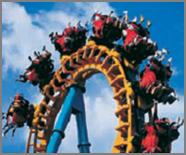
Six Flags’ rides are inspected daily by maintenance personnel during the operating season. These inspections include safety checks, as well as regular maintenance and are made through both visual inspections and test operations. The Company’s senior management and the park personnel evaluate the risk aspects of each park’s operation. Potential risks to employees and staff, as well as to the public, are constantly evaluated while contingency plans for potential emergency situations have been developed for each facility.
During the off-season, maintenance personnel examine the rides and repair, refurbish and rebuild them where necessary. This process includes x-raying and magnafluxing (a further examination for minute cracks and defects) steel portions of certain rides at high-stress points. Six Flags has approximately 800 full-time employees who devote substantially all of their time to maintaining the parks and their rides and attractions.
In addition to the Company’s maintenance and inspection procedures, third-party consultants are retained by Six Flags or its insurance carriers to perform an annual inspection of each park and all attractions and related maintenance procedures. The inspection results are provided in a written evaluation report along with written suggestions on how to improve various aspects of the park operations.
In certain states, state inspectors also conduct annual ride inspections before the beginning of each season. Other portions of each park are subject to inspections by local fire marshals and health and building department officials. Furthermore, Six Flags uses Ellis & Associates as water safety consultants at its parks in order to train life guards and audit safety procedures.
CONFIDENTIAL
Capital Expenditures

Six Flags regularly makes capital investments for new rides and attractions at its parks. The Company purchases both new and used rides and attractions and rotates rides among parks to provide customers with fresh attractions. Six Flags believes that the selective introduction of new rides and attractions is an important factor in achieving market penetration, encouraging longer visits, and ultimately increasing attendance and in-park spending.
In addition, Six Flags generally makes capital investments in the food, retail, games and other in-park areas to increase per capita guest spending. Six Flags also makes annual enhancements to park themes and landscapes in order to provide a more complete family oriented entertainment experience. In 2007, Six Flags began a multi-year initiative to improve its information technology infrastructure, to enhance its operational efficiencies.
Capital expenditures are planned on an annual basis with most expenditures made during the off-season. Expenditures for materials and services associated with maintaining assets, such as painting and inspecting existing rides, are expensed as incurred and are not included in capital expenditures.
Insurance
Six Flags maintains insurance of the type and in amounts that it believes are commercially reasonable and that are available to businesses in the industry. The Company maintains multi-layered general liability policies that provide for excess liability coverage of up to $100.0 million per occurrence. For incidents arising after November 15, 2003, the Company’s self-insured retention is $2.5 million per occurrence ($2.0 million per occurrence for the twelve months ended November 15, 2003 and $1.0 million per occurrence for the twelve months ended on November 15, 2002) for the Company’s parks in the U.S. and Canada and a nominal amount per occurrence for its park in Mexico. Defense costs are in addition to these retentions. In addition, for incidents arising after November 1, 2004 the Company has a one-time additional $0.5 million self-insured retention, in the aggregate, applicable to all claims in the policy year. The Company’s deductible after November 15, 2003 is $0.75 million for workers compensation claims ($0.5 million deductible for the period from November 15, 2001 to November 15, 2003).
Six Flags’ general liability policies cover the cost of punitive damages only in certain jurisdictions. Based upon reported claims and an estimate for incurred, but not reported claims, the Company accrues a liability for their self-insured retention contingencies. Six Flags also maintains fire and extended coverage, business interruption, terrorism and other forms of insurance typical to businesses in this industry. The fire and extended coverage policies insure the Company’s real and personal properties (other than land) against physical damage resulting from a variety of hazards.
Competition
Six Flags’ parks compete directly with other theme parks, water parks and amusement parks and indirectly with all other types of recreational facilities within their market areas, including movies, sports attractions and vacation travel. Accordingly, the Company’s business is and will continue to be subject to factors affecting the recreation and leisure-time industries such as general economic conditions and changes in discretionary consumer spending habits. Within each park’s regional market area, the principal factors affecting direct theme park competition include location, price, the uniqueness and perceived quality of the rides and attractions in a particular park, the atmosphere and cleanliness of a park and the quality of its food and entertainment.
CONFIDENTIAL
Seasonality

Six Flags’ operations are highly seasonal, with approximately 80% of park attendance and revenues occurring in the second and third calendar quarters of each year, with the most significant period falling between Memorial Day and Labor Day. In 2008, for example, the Company realized approximately 120% of its annual Adjusted EBITDA(1) during the months of June through October.
Environmental and Other Regulations

Six Flags’ operations are subject to federal, state and local environmental laws and regulations including laws and regulations governing water and sewer discharges, air emissions, soil and groundwater contamination, the maintenance of underground and aboveground storage tanks and the disposal of waste and hazardous materials.
In addition, the Company’s operations are subject to other local, state and federal governmental regulations including, without limitation, labor, health, safety, zoning and land use and minimum wage regulations applicable to theme park operations, and local and state regulations applicable to restaurant operations at each park. Finally, certain of the Company’s facilities are subject to laws and regulations relating to the care of animals.
Six Flags believes that it is in substantial compliance with applicable environmental and other laws and regulations and, although no assurance can be given, the Company does not foresee the need for any significant expenditure in this area in the near future.
Portions of the undeveloped areas at certain of the Company’s parks are classified as wetlands. Accordingly, Six Flags may need to obtain governmental permits and other approvals prior to conducting development activities that affect these areas, while future development may be limited and/or prohibited in some or all of these areas. Additionally, the presence of wetlands in portions of the Company’s undeveloped land could adversely affect its ability to dispose of such land and/or the price the Company receives in any such disposition.
The Company’s undeveloped areas that are not wetlands will require comprehensive land-use entitlement in order to make such land developable, which may require substantial time, cost and effort to meet zoning and other regulatory requirements. There can be no assurances that the outcome of such efforts would be successful, or that the increase in value, if any, will economically justify such expenditures of time, cost and effort.
Employees and Labor Matters
As of March 1, 2009, Six Flags employed approximately 2,000 full-time employees. During the 2008 operating season the Company employed approximately 28,500 seasonal employees. In this regard, Six Flags competes with other local employers for qualified students and other candidates on a season-by-season basis. As part of the seasonal employment program, the
(1) As defined in the Appendix
CONFIDENTIAL
Company employs a significant number of teenagers, which subjects the Company to child labor laws.
Approximately 16.2% of the Company’s full-time and approximately 13.0% of its seasonal employees are subject to labor agreements with local chapters of national unions. These labor agreements expire in January 2012 (Six Flags Over Texas, Six Flags St. Louis and one union at Six Flags Great Adventure), December 2011 (Six Flags Magic Mountain and the other union at Six Flags Great Adventure) and December 2010 (Six Flags Over Georgia). The labor agreements for La Ronde expire in various years ranging from December 2010 through December 2012. Other than a strike at La Ronde involving five employees, which was settled in January 2004, and recognitional picketing at Six Flags New England in February 2005 by 11 employees, Six Flags has not experienced any strikes or work stoppages by its employees. The Company considers its employee relations to be good.
Theme Parks Overview
|
Name of park and location |
|
Description |
|
Market area(s) |
|
Population within radius from park location |
|
Six Flags America Largo, MD |
|
523 acres—combination theme and water park and approximately 300 acres of potentially developable land |
|
Washington, D.C. and Baltimore |
|
· 7.0 million–50 miles · 11.7 million–100 miles |
|
Six Flags Discovery Kingdom Vallejo, CA |
|
138 acres—theme park plus marine and land animal exhibits |
|
San Francisco/Oakland and Sacramento |
|
· 5.5 million–50miles · 10.2 million–100 miles |
|
Six Flags Fiesta Texas San Antonio, TX |
|
224 acres—combination theme and water park |
|
San Antonio |
|
· 2.1 million–50 miles · 3.7 million–100 miles |
|
Six Flags Great Adventure/Six Flags Hurricane Harbor/Six Flags Wild Safari Jackson, NJ |
|
2,200 acres—separately gated theme park, water park and drive-through safari and approximately 700 acres of potentially developable land |
|
New York City and Philadelphia |
|
· 13.7 million–50 miles · 27.2 million–100 miles |
|
Six Flags Great America Gurnee, IL |
|
304 acres—combination theme and water park and approximately 20 acres of potentially developable land |
|
Chicago and Milwaukee |
|
· 8.5 million–50 miles · 13.1 million–100 miles |
|
|
|
|
|
|
|
|
|
Six Flags Kentucky Kingdom Louisville, KY |
|
58 acres—combination theme and water park |
|
Louisville and Lexington |
|
· 1.4 million–50 miles · 4.6 million–100 miles |
|
Six Flags Magic Mountain/Six Flags Hurricane Harbor Valencia, CA |
|
262 acres—separately gated theme park and water park |
|
Los Angeles |
|
· 10.6 million–50 miles · 17.8 million–100 miles |
|
Six Flags Mexico Mexico City, Mexico |
|
110 acres—theme park |
|
Mexico City, Mexico |
|
· 30.0 million–50 miles · 42.0 million–100 miles |
|
Six Flags New England Agawam, MA |
|
284 acres—combination theme and water park |
|
Springfield, Providence, Hartford/New Haven, and Boston |
|
· 3.1 million–50 miles · 15.2 million–100 miles |
|
Six Flags Over Georgia Austell, GA/Six Flags White Water Atlanta Marietta, GA |
|
359 acres—separately gated theme park and water park on 290 acres and 69 acres, respectively |
|
Atlanta |
|
· 4.2 million–50 miles · 7.0 million–100 miles |
|
Six Flags Over Texas/Six Flags Hurricane Harbor Arlington, TX |
|
264 acres—separately gated theme park and water park on 217 and 47 acres, respectively |
|
Dallas/Fort Worth |
|
· 6.5 million–50 miles · 7.1 million–100 miles |
|
Six Flags St. Louis Eureka, MO |
|
497 acres—combination theme and water park and approximately 240 acres of potentially developable land |
|
St. Louis |
|
· 2.6 million–50 miles · 3.8 million–100 miles |
|
La Ronde Montreal, Canada |
|
Theme park on 146 acres |
|
Montreal, Quebec, Canada |
|
· 4.3 million–50 miles · 5.8 million–100 miles |
|
The Great Escape and Splashwater Kingdom/ Six Flags Great Escape Lodge & Indoor Waterpark Lake George, NY |
|
351 acres—combination theme and water park, plus 200 room hotel and 38,000 square foot indoor waterpark |
|
Albany |
|
· 1.1 million–50 miles · 3.1 million–100 miles |
8. Industry overview
Industry composition and recent performance
Theme parks and amusement parks traditionally feature themed attractions and “thrill rides” set in family-friendly environments. The market is broadly divided into destination and regional parks — regional theme parks draw most of their visitors from local markets, whereas destination parks draw visitors from national and international locales.
The industry consists of thousands of small-to-medium-sized operations, with heavy concentration at the top of the industry where the top five firms accounted for about 46 percent of overall attendance in 2007.(1) While the largest companies generally operate the most popular parks, the majority of theme and amusement parks have fewer than 500,000 visitors per year. Key 2008 attendance park figures are listed below.
2008 Attendance Figures
· 122.7 million: Total visits to the top 20 parks in North America, level with the performance in 2007. Between 2005 and 2008 the top 20 North American parks grew by a total of 3.9 percent.
· 57.4 million: Attendance for the top 20 European parks, representing a growth rate of 1.1 percent. Attendance growth of 7.6 percent from 2005-2008 for top European parks.
· 12.2 million: Visits to top 10 parks in Mexico and Latin America
· 66.9 million: Total attendance to top 10 Asian/Pacific Rim parks
· 186 million: The total theme park attendance for top 25 worldwide parks in 2008, down 0.4% from 2007
· 12.5 million: Combined visitation to the top 15 US waterparks, growth of 1.8 percent from 2007
· 20.2 million: Total attendance to top 20 worldwide waterparks, up 5.6 percent from 2007.
Source: TEA/ERA 2008 Attendance Report
The worldwide theme and amusement park market was estimated to be $24.1 billion in 2007, with the U.S. accounting for approximately 50%, or $12.0 billion.
Theme vs. Amusement parks
Traditional amusement parks consist of thrill rides and attractions based in a carnival-like atmosphere. Theme parks are usually designed with the objective of providing an experience based on one or more themes that encompass all aspects of the park, including rides, landscape, shows and food. Theme parks are usually considered to appeal to a broader age demographic in larger geographic areas. Six Flags’ parks, with attractions such as themed rides and attractions based on Warner Bros. and DC Comics characters, are generally considered theme parks.
Regional vs. destination theme parks
Regional parks usually operate seasonally and remain closed for a part of the year, but guests tend to visit multiple times per year. Visitors to regional parks usually plan their trips days in advance as an inexpensive day trip, and the regional park industry is therefore less vulnerable to economic cycles but more susceptible to bad weather. Regional park operators also compete with other forms of traditional entertainment. The major operators of regional parks in the U.S. are Six Flags and Cedar Fair.
Destination parks attract tourist audiences who plan their trips months in advance. Most of these parks are located in either Orlando, Florida or Southern California. Destination parks usually operate year-round but they incur minimal repeat visitation. Visitors consider their trips to destination parks to be expensive
(1) Source: Freedonia Focus on Amusement Parks, October 2008
vacation activities, and destination park operators are therefore more vulnerable to economic cycles and must compete with other forms of travel and tourism. The daily per capita expenditure of a visitor at a destination park can be twice as much as the expenditure at a regional park. The major operators of destination parks in the U.S. are Disney, Seaworld and Universal Orlando.
Most theme park operators focus on either the destination or regional market, although there are exceptions (for example, Seaworld is generally considered a destination park operator because it derives the majority of its revenue from destination parks, but it also operates a few regional parks).
Revenue drivers
Two main drivers of revenue in the theme park business are attendance and in-park spending. Admission spending for the average ticket is substantially lower than the gate price reflecting a combination of pre-booked group sales tickets, season passes, and advance/front gate ticket purchasing. Attendance is driven by an overall park experience, which creates special experiences and shared memories with families and friends, offers an escape from the daily routine and delivers different and exciting thrills for the entire family. Theme parks spike demand and urgency to visit by adding unique rides and attractions targeted to families and teens. Attendance frequency and loyalty are built by providing a quality, friendly and safe guest experience that is repeatable, with strategic pricing and promotional programs influencing guest perception of value.
In-park spending encompasses food, merchandising and games, which increase the per capita spending of each visitor substantially above the standalone price of admission. Besides promoting multiple visits via seasonal passes, parks aim to increase per capita spending by maximizing the number of hours spent by visitors inside the park and by providing a variety of food, games and merchandising.
Pricing strategies
Parks are experimenting with various pricing structures to maximize revenues. The pay-one-price admission (includes all rides and attractions) is the most common pricing structure used. Other pricing structures include: 1) charging a lower gate price for park admission and shows only, excluding rides; 2) charging for rides individually; and 3) charging for admission to specific areas of the park. In recent years, sales of Flash Passes, which permit guests to bypass ride lines, have been a successful boon to sales. Season pass sales and promotions through corporate partnerships offer multiple opportunities for reduced price admission. Since seasonality plays a large role in the timing of revenues, targeted marketing initiatives such as discounts, group packages and season tickets can help increase attendance at both ends of the peak season.
Capital expenditures
Because new rides and attractions drive attendance growth, theme parks and amusement parks require regular capital expenditures to upgrade and add attractions on a regular basis. The need for new attractions from season to season is particularly relevant for regional parks, which attract the same base of visitors every year. Regional operators may also have the option to move rides, reprogram existing rides, or stagger the launch of new attractions within their portfolio of parks in order to maximize the return on investment.
Industry outlook
IBISWorld estimates that over the five years to 2013, industry revenue will increase at an average annual rate of 1.8%. As it has been more significantly impacted in 2009 than the overall industry due to a variety of unique factors including swine flu and its bankruptcy filing, Six Flags is projecting growth that exceeds the industry as a whole. For 2010 to 2013, Six Flags is projecting revenue growth at a CAGR of 3.8%, more than twice that of the industry. Set forth below is the projected revenue growth for both Six Flags and the Amusement Industry.
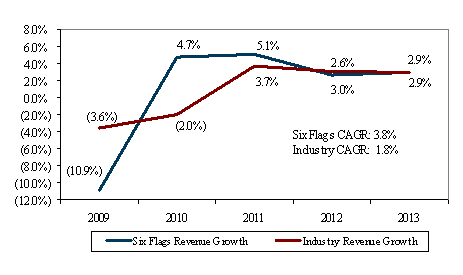
9. Management team
Team overview
Set forth below is the current executive management team that, with one exception, joined Six Flags in late 2005 and early 2006 and effectuated the financial and operational turnaround described herein.
Key management

Mark Shapiro, Chief Executive Officer and President
Mr. Shapiro has served as President, Chief Executive Officer and a Director of the Company since December 2005. From September 2002 to October 2005, Mr. Shapiro served as the Executive Vice President, Programming and Production of ESPN, Inc. From July 2001 to September 2002, he served as Senior Vice President and General Manager, Programming at ESPN. Prior to July 2001, he was Vice President and General Manager of ESPN Classic and ESPN Original Entertainment. Mr. Shapiro is also a Director of Live Nation, Inc. and the Tribune Company, and a Director and Executive Vice Chairman of dick clark productions, inc.
Jeffrey R. Speed, Executive Vice President and Chief Financial Officer
Mr. Speed has both a broad-based financial background and extensive experience in the media, entertainment, and theme park industries. Before joining Six Flags, Mr. Speed served as Senior Vice President and Chief Financial Officer of Euro Disney S.A.S. Prior to Euro Disney, Mr. Speed served as Vice President, Corporate Finance and Assistant Treasurer for The Walt Disney Company, where he was responsible for worldwide capital markets activities, structured and project finance initiatives (including Euro Disney and Hong Kong Disneyland), syndication of revolving credit facilities and Disney’s overall banking and rating agency relationships. Mr. Speed is also a board member and audit committee member of World Wrestling Entertainment, Inc. (NYSE: WWE) and Chief Financial Officer of dick clark productions, inc.
Mark Quenzel, Executive Vice President Park Strategy and Management
Mr. Quenzel oversees all park operations, strategy, and safety for the Six Flags parks. Mr. Quenzel joined Six Flags following 15 years with ESPN, where he served as Senior Vice President, Programming and Production. In that capacity, he ran four divisions: Owned Events, Outdoors, Remote Production and Remote Facilities, and supervised 375 fulltime employees and over 4,000 seasonal providers. Mr. Quenzel was also part of the team that created the popular X Games franchise as well as the Great Outdoor Games, and during his tenure he oversaw a number of major sport properties and brands such as NASCAR, NHL, MLB and B.A.S.S.
Michael Antinoro, Executive Vice President Entertainment and Marketing
Mr. Antinoro oversees all aspects of Six Flags’ advertising, promotions, entertainment, marketing and communications. Mr. Antinoro formerly served as the Executive Producer of ESPN Original Entertainment (EOE), the core creative group that led the ESPN brand into non-traditional sports and entertainment programming. During his tenure at EOE, Mr. Antinoro created a number of successful original movies, a critically acclaimed dramatic series, talk, reality and game shows, documentaries and “The World Series of Poker” franchise. EOE won the prestigious Peabody Award in 2002 and was nominated for more than
20 Sports Emmys. Prior to his work at EOE, Mr. Antinoro served directly under Mark Shapiro as coordinating producer of ESPN’s landmark SportsCentury series.
Louis Koskovolis, Executive Vice President Corporate Alliances
Mr. Koskovolis oversees the Corporate Alliances group which focuses on developing key national, regional and local sponsorships for all Six Flags parks and creates cross-promotional platforms which enable Six Flags partners to showcase their products and services while providing Six Flags with added exposure through partners’ advertising and marketing assets. Mr. Koskovolis joined Six Flags from his position as Executive Vice President of Multi-Media Sales for ESPN and ABC Sports in addition to serving in leadership roles in the company’s National Television Sales and Customer Marketing organizations.
Andrew Schleimer, Executive Vice President of Strategic Development and In-Park Services
Mr. Schleimer oversees Six Flags’ Strategic Development and In-Park Services, a division that focuses on increasing company revenue and enhancing the park experience through agreements with branded food, beverage, equipment, service and retail partners. Mr. Schleimer is also responsible for the international licensing and new business development. He has a background in investment banking with a focus on mergers and acquisitions, and joined Six Flags from UBS Investment Bank, where he served as Vice President in the bank’s Mergers and Acquisitions department. At UBS, Mr. Schleimer advised on over $150 billion of transactions in the media, entertainment, technology, telecom and consumer products sectors.
James Coughlin, General Counsel
Mr. Coughlin has served as the Company’s General Counsel since 1998. Prior to becoming the Company’s chief legal counsel, Mr. Coughlin practiced law at several private law firms, most recently at the former Baer Marks & Upham firm in New York City. Mr. Coughlin graduated from Harvard University with a Bachelor of Arts degree, and from Boston University School of Law with a Juris Doctor degree.
10. Historic and financial overview
Summary financials ($millions)
|
|
|
2006 |
|
2007 |
|
2008 |
|
2009P |
|
2009PCA(1),(2) |
|
|||||
|
Ticket revenue |
|
$ |
522.7 |
|
$ |
524.2 |
|
$ |
534.8 |
|
$ |
486.0 |
|
$ |
486.0 |
|
|
In-Park revenue |
|
393.8 |
|
408.0 |
|
427.5 |
|
381.9 |
|
381.9 |
|
|||||
|
Sponsorship, Licensing & Other |
|
25.7 |
|
38.6 |
|
59.0 |
|
42.2 |
|
42.2 |
|
|||||
|
Total revenue |
|
$ |
942.2 |
|
$ |
970.8 |
|
$ |
1,021.3 |
|
$ |
910.2 |
|
$ |
910.2 |
|
|
Cost of sales |
|
(80.0 |
) |
(81.5 |
) |
(86.4 |
) |
(77.1 |
) |
(77.1 |
) |
|||||
|
Gross profit |
|
$ |
862.2 |
|
$ |
889.3 |
|
$ |
934.9 |
|
$ |
833.1 |
|
$ |
833.1 |
|
|
Gross margin % |
|
91.5 |
% |
91.6 |
% |
91.5 |
% |
91.5 |
% |
91.5 |
% |
|||||
|
Cash operating expenses(3),(4) |
|
(623.0 |
) |
(661.5 |
) |
(627.4 |
) |
(619.9 |
) |
(603.9 |
) |
|||||
|
As % of revenues |
|
66.1 |
% |
68.1 |
% |
61.4 |
% |
68.1 |
% |
66.3 |
% |
|||||
|
Modified EBITDA(4) |
|
$ |
239.2 |
|
$ |
227.8 |
|
$ |
307.5 |
|
$ |
213.1 |
|
$ |
229.1 |
|
|
Modified EBITDA margin |
|
25.4 |
% |
23.5 |
% |
30.1 |
% |
23.4 |
% |
25.2 |
% |
|||||
|
Min int in earnings - EBITDA |
|
(44.4 |
) |
(38.2 |
) |
(32.2 |
) |
(23.1 |
) |
(23.1 |
) |
|||||
|
Adjusted EBITDA(4) |
|
$ |
194.8 |
|
$ |
189.6 |
|
$ |
275.3 |
|
$ |
190.0 |
|
$ |
206.0 |
|
|
|
|
|
|
|
|
|
|
|
|
|
|
|||||
|
Cash interest (Net) |
|
(187.6 |
) |
(196.5 |
) |
(157.5 |
) |
(82.9 |
) |
(50.0 |
) |
|||||
|
Capital expenditures (Net) |
|
(101.1 |
) |
(114.1 |
) |
(90.3 |
) |
(100.0 |
) |
(91.0 |
) |
|||||
|
PIERS cash dividends |
|
(20.8 |
) |
(20.8 |
) |
(5.2 |
) |
0.0 |
|
0.0 |
|
|||||
|
Cash paid for debt issuance costs |
|
(3.0 |
) |
(19.1 |
) |
(9.7 |
) |
0.0 |
|
0.0 |
|
|||||
|
Cash taxes |
|
(4.7 |
) |
(5.0 |
) |
(7.0 |
) |
(9.0 |
) |
(9.0 |
) |
|||||
|
Free Cash Flow(4) |
|
$ |
(122.4 |
) |
$ |
(166.0 |
) |
$ |
5.6 |
|
$ |
(1.9 |
) |
$ |
56.0 |
|
|
Cash flow from operating activities |
|
56.3 |
|
9.7 |
|
107.7 |
|
109.8 |
|
125.8 |
|
|||||
|
Cash flow from investing activities |
|
(40.0 |
) |
64.2 |
|
(93.7 |
) |
(85.9 |
) |
(76.9 |
) |
|||||
|
Cash flow from financing activities |
|
(72.4 |
) |
(70.1 |
) |
169.7 |
|
(64.5 |
) |
(64.5 |
) |
|||||
From 2006 through 2008, total annual revenues increased by approximately 8.4% (a 4.1% CAGR) as a result of management’s highly successful three-year turnaround plan. Total revenue per capita, a key measure of revenue growth, increased from $37.93 to $40.30 (a 3.1% CAGR), while total revenue per capita at the closest comparable company, Cedar Fair LP, remained essentially flat throughout the same period. 2008 Adjusted EBITDA reached $275.3 million. This year-over-year growth represents an Adjusted EBITDA increase of approximately 45.1% and resulted in Six Flags generating positive Free Cash Flow for the first time in the Company’s history.
(1) Projected 2009 Cost Adjusted EBITDA of $206MM, which comprises the projected 2009 Adjusted EBITDA of $190MM and $16MM in additional cost savings projected for 2010 applied to such projected 2009 Adjusted EBITDA
(2) Projected 2009 Cost Adjusted Capital Expenditures (net) of $91MM, which comprises the projected 2009 Capital Expenditures (net) of $100MM and $9MM in additional capital expenditure reductions projected for 2010 applied to such projected 2009 Capital Expenditures (net)
(3) Excludes costs associated with the change of corporate management that occurred in late 2005 and early 2006 (approximately $13.9 million recognized as expense in 2006)
(4) As defined in the Appendix
|
Attendance/total revenue per capita |
|
Consolidated financial performance |
|
|
|
|
|
|
|
|
2009 Financial performance
The Company’s financial performance in 2009 has been adversely impacted by several factors, including:
· Overall deterioration in the US economy, including rising levels of national unemployment
· H1N1 (“Swine Flu”) concerns primarily at parks in Mexico and Texas
· the Mexico park was closed for 2 weeks in the spring
· Inclement weather at the Northeast parks, especially in June and during October weekends
· Negative media reports surrounding the Company’s bankruptcy filing in the middle of the peak operating season, three weeks prior to the 4th of July weekend
These factors resulted in an attendance decline of approximately 1.5 million (6.2%) as of November 4th compared to the previous year, and lower revenue and Adjusted EBITDA(1) for the Company in this period. For the year end, total revenue per capita is expected to be down 5.1% ($2.05) to prior year. Ticket per capita is estimated to be down 3.2% to prior year. The lower ticket per capita was driven by lower season pass pricing and the exchange rate impact on revenues at the parks in Mexico and Canada, partially offset by a decrease in complimentary tickets. Additionally, in-park per capita is expected to be down 4.9% to the prior year driven by across-the-board weakness in guest spending and the exchange rate translation impact on revenues at the parks in Mexico and Canada.
(1) As defined in the Appendix
Overall, the Company expects 2009 revenues down 10.9% ($111.1 million) to the prior year, and ticket revenues down 9.1% ($48.7 million) to the prior year. The Company expects in-park revenues to be down 10.9% ($45.6 million) to the prior year. The non-renewal of a China theme park exclusivity deal and the delay of the Dubai project also resulted in lower licensing revenues of $16.8 million. A favorable cash operating expense decrease of 1.2% ($7.5 million) helped offset these reductions. Adjusted EBITDA(1) is forecasted to be approximately $190 million.
The impacts of these factors on Adjusted EBITDA(1) is presented in the following chart below that shows the bridge from 2008 to 2009 Adjusted EBITDA(1).
Adjusted EBITDA(1) Bridge 2008-2009

(1) As defined in the Appendix
(2) Projected 2009 Cost Adjusted EBITDA of $206MM, which comprises the projected 2009 Adjusted EBITDA of $190MM and $16MM in additional cost savings projected for 2010 applied to such projected 2009 Adjusted EBITDA
11. Financial Projections
1. Responsibility for and Purpose of the Projections
As a condition to confirmation of a Plan of Reorganization (the “Plan”), the Bankruptcy Code requires, among other things, that the Bankruptcy Court determine that confirmation is not likely to be followed by the liquidation or the need for further financial reorganization of the debtor. This standard is generally referred to as “feasibility”. In connection with the development of the Plan, and for purposes of determining whether the Plan satisfies this feasibility standard, Six Flags’ management has analyzed the ability of the Company to meet its obligations under the Plan and retain sufficient liquidity and capital resources to conduct their business.
Management believes that the Plan meets the Bankruptcy Code’s feasibility requirement that the Plan confirmation is not likely to be followed by liquidation or the need for further financial reorganization of the Company or any successor under the Plan.
2. Financial Projections
In connection with the development of the Plan, and for the purposes of determining whether the Plan satisfies the feasibility standard, Six Flags analyzed its ability to satisfy financial obligations while maintaining sufficient liquidity and capital resources. In this regard Six Flags, in consultation with their advisors, projected condensed consolidated operating data and projected condensed consolidated statements of cash flows of Six Flags for the years ending December 31, 2009 through 2013, and the projected condensed consolidated balance sheets of SFI as at December 31, 2009, 2010, 2011, 2012 and 2013 (collectively, the “Projections”).
The Projections, which are set forth herein and modified where appropriate to comply with the requirements of Regulation G, are based on a number of assumptions, and while Six Flags has prepared the Projections in good faith and believe the assumptions to be reasonable, it is important to note that Six Flags can provide no assurance that such assumptions will ultimately be realized. The Projections should be read in conjunction with the assumptions and qualifications outlined herein, as well as those risk factors described in Article VIII of the Amended Disclosure Statement and in Six Flags’ Quarterly Report on Form 10-Q for the third quarter of 2009 and with the audited consolidated financial statements for the fiscal year ended December 31, 2008 contained in Six Flags’ 2008 Form 10-K and with Six Flags’ third quarter 2009 Form 10-Q. Because these documents contain important information, users of this document are encouraged to read them. The forms 10-K and 10-Q are available free from Six Flags at www.sixflags.com and the SEC at www.sec.gov.
The Projections were prepared in November 2009 and reflect the anticipated impact of the Plan and actual results through September 2009 (updated for the most recent 2009 forecast and assuming an April 2010 Effective Date) and they reflect Six Flags’ judgment of expected future operating and business conditions, which are subject to change. Therefore, the Projections assume that the Plan will be implemented in accordance with its stated terms. The Projections are inherently uncertain as they are based on estimates and assumptions that rely on the forecast of key economic variables, including (but not limited to) unemployment, consumer confidence, personal savings rates and consumer spending trends which impact attendance at the theme parks and demand for in-park and other products and services, U.S. amusement and theme park industry projections, capital market conditions, the ability to manage increases in its costs (particularly labor and utilities), working capital needs and capital expenditures, and the ability to maintain good customer relations and appropriately manage the growth of operations. In addition, the Projections make assumptions with regard to certain operations that are not majority owned by Six Flags, including dcp, and therefore results of operating decisions and strategic direction could vary materially from the forecast since Six Flags does not ultimately control these entities. Although considered reasonable by Six Flags as of the date hereof, the Projections are subject to significant business, economic and competitive uncertainties. Accordingly, such projections, estimates
and assumptions are not necessarily indicative of current values (including equity value), or future performance, which may be significantly less favorable or more favorable than as set forth.
The Projections assume an Effective Date in April 2010 with allowed claims and allowed interests treated as described in the Plan. If Six Flags does not emerge from Chapter 11 as currently scheduled, additional administrative expenses will be incurred until such time as a Plan is confirmed and becomes effective. These administrative expenses could significantly impact Six Flags’ cash flows if the Effective Date is materially later than the current schedule.
Any forward-looking statement made by Six Flags’ in the Projections, or on Six Flags’ behalf by Six Flags’ directors, officers or employees related to the information contained herein, speaks only as of the date of the Projections. Factors or events that could cause Six Flags’ actual results to differ may emerge from time to time, and it is not possible for Six Flags to predict all of them. Six Flags undertakes no obligation to publicly update any forward-looking statement, whether as a result of new information, future developments or otherwise.
Six Flags does not, as a matter of course, publish their business plans and strategies or projections or anticipated financial position or results of operations. Accordingly, Six Flags does not anticipate that they will, and disclaim any obligation to, furnish updated business plans or projections to holders of claims or interests after the confirmation date, or to include such information in documents required to be filed with the SEC (if any) or otherwise make such information public.
THE PROJECTIONS WERE NOT PREPARED WITH A VIEW TOWARD PUBLIC DISCLOSURE OR COMPLIANCE WITH PRACTICES RECOGNIZED TO BE IN ACCORDANCE WITH THE GENERALLY ACCEPTED ACCOUNTING PRINCIPLES, PUBLISHED GUIDELINES OF THE SEC, THE RULES AND REGULATIONS PROMULGATED BY THE SEC REGARDING PROJECTIONS OR THE GUIDELINES ESTABLISHED BY THE AMERICAN INSTITUTE OF CERTIFIED PUBLIC ACCOUNTANTS REGARDING PROJECTIONS OR FORECASTS. FURTHERMORE, THE PROJECTIONS HAVE NOT BEEN AUDITED OR REVIEWED BY INDEPENDENT CERTIFIED ACCOUNTANTS.
THE PROJECTIONS ARE INHERENTLY SPECULATIVE AND REQUIRE A SIGNIFICANT AMOUNT OF ESTIMATED OR FORECASTED DATA. ALTHOUGH EVERY EFFORT WAS MADE TO BE ACCURATE, THE PROJECTIONS ARE ONLY AN ESTIMATE, AND ACTUAL RESULTS MAY VARY CONSIDERABLY FROM THE PROJECTIONS. IN ADDITION, THE UNCERTAINTIES WHICH ARE INHERENT IN THE PROJECTIONS INCREASE FOR LATER YEARS IN THE PROJECTION PERIOD, DUE TO INCREASED DIFFICULTY ASSOCIATED WITH FORECASTING LEVELS OF ECONOMIC ACTIVITY AND SIX FLAGS’ PERFORMANCE AT MORE DISTANT POINTS IN THE FUTURE. CONSEQUENTLY, THE PROJECTED INFORMATION INCLUDED HEREIN SHOULD NOT BE REGARDED AS A REPRESENTATION BY THE COMPANY, THE COMPANY’S ADVISORS OR ANY OTHER PERSON THAT THE PROJECTED RESULTS WILL BE ACHIEVED.
The Projections assume that (i) the Plan will be confirmed and consummated in accordance with its terms, (ii) there will be no material change in legislation or regulations, or the administration thereof, that will have an unexpected effect on the operations of the Company, (iii) there will be no change in generally accepted accounting principles in the United States that will have a material effect on the reported financial results of the Company, (iv) the application of Fresh Start Reporting will not materially change the Company’s revenue accounting procedures and (v) there will be no material contingent or unliquidated litigation or indemnity claims applicable to the Company, including with regards to the Partnership Parks. To the extent that the assumptions inherent in the Projections are based upon future business decisions and objectives, they are subject to change. In addition, although they are presented with numerical specificity and considered reasonable by the Company when taken as a whole, the assumptions and estimates underlying the Projections are subject to significant business, economic and competitive uncertainties and contingencies, many of which will be beyond the control of the Company.
Accordingly, the Projections are only an estimate and, therefore, necessarily speculative in nature. It can be expected that some or all of the assumptions in the Projections will not be realized and that actual results will vary from the Projections, which variations may be material and are likely to increase over time. The Projections should therefore not be regarded as a representation by the Borrower or any other person that the results set forth in the Projections will be achieved. In light of the foregoing, readers are cautioned not to place undue reliance on the Projections. The Projections should be read together with the information, the assumptions, qualifications and footnotes to tables containing the Projections set forth herein and included in the Company’s other financial statements as publicly filed with the SEC.
Projected balance sheet
Projected condensed consolidated balance sheets(1)
|
|
|
December 31 |
|
|||||||||||||
|
($000s) |
|
2009P |
|
2010P |
|
2011P |
|
2012P |
|
2013P |
|
|||||
|
Assets: |
|
|
|
|
|
|
|
|
|
|
|
|||||
|
Cash |
|
$ |
170,140 |
|
$ |
62,408 |
|
$ |
100,658 |
|
$ |
188,247 |
|
$ |
315,960 |
|
|
Accounts Receivable |
|
18,437 |
|
16,883 |
|
17,068 |
|
17,114 |
|
17,202 |
|
|||||
|
Inventories |
|
19,444 |
|
20,125 |
|
20,626 |
|
21,282 |
|
21,760 |
|
|||||
|
Prepaid Expenses and other |
|
40,823 |
|
41,783 |
|
43,065 |
|
42,795 |
|
43,133 |
|
|||||
|
Total Current Assets |
|
$ |
248,844 |
|
$ |
141,199 |
|
$ |
181,417 |
|
$ |
269,438 |
|
$ |
398,055 |
|
|
|
|
|
|
|
|
|
|
|
|
|
|
|||||
|
Net Property Plant & Equipment |
|
1,517,349 |
|
1,452,554 |
|
1,379,359 |
|
1,295,598 |
|
1,211,269 |
|
|||||
|
Other Assets |
|
1,145,117 |
|
404,115 |
|
404,396 |
|
407,898 |
|
402,521 |
|
|||||
|
Total Assets |
|
$ |
2,911,310 |
|
$ |
1,997,868 |
|
$ |
1,965,172 |
|
$ |
1,972,934 |
|
$ |
2,011,845 |
|
|
|
|
|
|
|
|
|
|
|
|
|
|
|||||
|
Liabilities and Equity: |
|
|
|
|
|
|
|
|
|
|
|
|||||
|
Accounts Payable |
|
$ |
54,801 |
|
$ |
32,501 |
|
$ |
33,496 |
|
$ |
33,286 |
|
$ |
33,549 |
|
|
Accrued Expenses |
|
102,397 |
|
99,041 |
|
102,081 |
|
101,440 |
|
102,240 |
|
|||||
|
Other Current Liabilities |
|
79,396 |
|
26,363 |
|
26,238 |
|
26,449 |
|
26,850 |
|
|||||
|
Total Current Liabilities |
|
$ |
236,594 |
|
$ |
157,904 |
|
$ |
161,815 |
|
$ |
161,175 |
|
$ |
162,639 |
|
|
|
|
|
|
|
|
|
|
|
|
|
|
|||||
|
Long-Term Debt (Including Current Portion) |
|
$ |
2,411,835 |
|
$ |
705,048 |
|
$ |
679,897 |
|
$ |
665,600 |
|
$ |
659,100 |
|
|
Liabilities from Discontinued Operations |
|
— |
|
— |
|
— |
|
— |
|
— |
|
|||||
|
Other Long-Term Liabilities |
|
60,892 |
|
57,992 |
|
48,992 |
|
46,092 |
|
43,193 |
|
|||||
|
Deferred Income Taxes |
|
118,231 |
|
114,457 |
|
127,246 |
|
151,871 |
|
185,868 |
|
|||||
|
Redeemable Noncontrolling Interests |
|
355,933 |
|
325,933 |
|
295,933 |
|
265,933 |
|
235,933 |
|
|||||
|
Manditorily Redeemable Preferred Stock |
|
313,311 |
|
— |
|
— |
|
— |
|
— |
|
|||||
|
Total Stockholders’ Equity |
|
(585,487 |
) |
636,535 |
|
651,290 |
|
682,262 |
|
725,112 |
|
|||||
|
Total Stockholders’ Equity and Liabilities |
|
$ |
2,911,310 |
|
$ |
1,997,868 |
|
$ |
1,965,172 |
|
$ |
1,972,934 |
|
$ |
2,011,845 |
|
(1) Does not include the impact of fresh start reporting, aside from an assumed revaluation of intangible assets (included in other assets) and an assumed stockholders’ equity of $670MM upon emergence from Chapter 11 reorganization
Projected operations
Projected condensed consolidated operating data
|
|
|
Years ended December 31 |
|
|||||||||||||
|
($000s) |
|
2009P |
|
2010P |
|
2011P |
|
2012P |
|
2013P |
|
|||||
|
Net Sales |
|
$ |
910,184 |
|
$ |
953,263 |
|
$ |
1,002,205 |
|
$ |
1,028,617 |
|
$ |
1,058,244 |
|
|
Cost of Sales |
|
77,118 |
|
81,158 |
|
83,180 |
|
85,825 |
|
87,752 |
|
|||||
|
Gross Profit |
|
$ |
833,066 |
|
$ |
872,105 |
|
$ |
919,025 |
|
$ |
942,792 |
|
$ |
970,492 |
|
|
Gross Margin |
|
91.5 |
% |
91.5 |
% |
91.7 |
% |
91.7 |
% |
91.7 |
% |
|||||
|
Cash Operating Expenses |
|
619,931 |
|
619,000 |
|
638,000 |
|
634,000 |
|
639,000 |
|
|||||
|
Modified EBITDA |
|
$ |
213,135 |
|
$ |
253,105 |
|
$ |
281,025 |
|
$ |
308,792 |
|
$ |
331,492 |
|
|
Modified EBITDA Margin |
|
23.4 |
% |
26.6 |
% |
28.0 |
% |
30.0 |
% |
31.3 |
% |
|||||
|
Less: Minority Int. EBITDA/Equity in Earnings EBITDA |
|
(23,136 |
) |
(22,105 |
) |
(20,025 |
) |
(17,792 |
) |
(15,493 |
) |
|||||
|
Adjusted EBITDA |
|
$ |
190,000 |
|
$ |
231,000 |
|
$ |
261,000 |
|
$ |
291,000 |
|
$ |
316,000 |
|
|
Adjusted EBITDA Margin |
|
20.9 |
% |
24.2 |
% |
26.0 |
% |
28.3 |
% |
29.9 |
% |
|||||
|
|
|
|
|
|
|
|
|
|
|
|
|
|||||
|
Less Depreciation & Amortization |
|
(142,647 |
) |
(149,178 |
) |
(155,074 |
) |
(160,520 |
) |
(166,066 |
) |
|||||
|
Less Other Non-Cash Expenses |
|
(7,540 |
) |
(7,500 |
) |
(5,000 |
) |
(5,000 |
) |
(5,000 |
) |
|||||
|
Less Stock Compensation |
|
(2,730 |
) |
(23,288 |
) |
(10,401 |
) |
(6,254 |
) |
(1,478 |
) |
|||||
|
Less Interest Expense (Net) |
|
(105,301 |
) |
(56,827 |
) |
(52,409 |
) |
(49,639 |
) |
(47,712 |
) |
|||||
|
Less Other Expense (Net) |
|
(126,230 |
) |
(64,211 |
) |
(450 |
) |
280 |
|
147 |
|
|||||
|
Less Taxes |
|
(2,936 |
) |
(6,226 |
) |
(22,788 |
) |
(34,625 |
) |
(43,997 |
) |
|||||
|
Less Discontinued Operations |
|
1,478 |
|
0 |
|
0 |
|
0 |
|
0 |
|
|||||
|
Net Income / (Loss) |
|
$ |
(172,771 |
) |
$ |
(54,125 |
) |
$ |
34,903 |
|
$ |
53,034 |
|
$ |
67,388 |
|
|
Less: Net Income attributable to noncontrolling interests |
|
(35,072 |
) |
(32,629 |
) |
(30,549 |
) |
(28,316 |
) |
(26,016 |
) |
|||||
|
Net Income / (Loss) attributable to Six Flags, Inc |
|
$ |
(207,843 |
) |
$ |
(86,754 |
) |
$ |
4,354 |
|
$ |
24,718 |
|
$ |
41,372 |
|
Projected condensed consolidated statements of cash flows
|
|
|
Years ended December 31 |
|
|||||||||||||
|
($000s) |
|
2009P |
|
2010P |
|
2011P |
|
2012P |
|
2013P |
|
|||||
|
Cash Flow from Operating Activities |
|
|
|
|
|
|
|
|
|
|
|
|||||
|
Net Income / (Loss) |
|
$ |
(172,771 |
) |
$ |
(54,125 |
) |
$ |
34,903 |
|
$ |
53,034 |
|
$ |
67,388 |
|
|
Depreciation and Amortization |
|
142,647 |
|
149,178 |
|
155,074 |
|
160,520 |
|
166,066 |
|
|||||
|
Net Change in Working Capital |
|
52,904 |
|
(21,164 |
) |
1,942 |
|
(1,071 |
) |
561 |
|
|||||
|
Other Cash Flows from Operations |
|
87,027 |
|
(16,194 |
) |
24,029 |
|
37,719 |
|
42,215 |
|
|||||
|
Cash Flow from Operating Activities |
|
$ |
109,807 |
|
$ |
57,694 |
|
$ |
215,948 |
|
$ |
250,202 |
|
$ |
276,230 |
|
|
|
|
|
|
|
|
|
|
|
|
|
|
|||||
|
Cash Flow From Investing |
|
$ |
(85,898 |
) |
$ |
(91,000 |
) |
$ |
(92,000 |
) |
$ |
(90,000 |
) |
$ |
(86,000 |
) |
|
|
|
|
|
|
|
|
|
|
|
|
|
|||||
|
Cash Flow From Financing |
|
$ |
(64,520 |
) |
$ |
(74,425 |
) |
$ |
(85,699 |
) |
$ |
(72,613 |
) |
$ |
(62,516 |
) |
|
Effect of Exchange Rate |
|
419 |
|
— |
|
— |
|
— |
|
— |
|
|||||
|
Net Cash Flow |
|
$ |
(40,192 |
) |
$ |
(107,731 |
) |
$ |
38,249 |
|
$ |
87,589 |
|
$ |
127,714 |
|
|
|
|
|
|
|
|
|
|
|
|
|
|
|||||
|
Beginning Cash and Cash Equivalents |
|
$ |
210,332 |
|
$ |
170,140 |
|
$ |
62,408 |
|
$ |
100,658 |
|
$ |
188,247 |
|
|
Ending Cash and Cash Equivalents |
|
$ |
170,140 |
|
$ |
62,408 |
|
$ |
100,658 |
|
$ |
188,247 |
|
$ |
315,960 |
|
Projected Financial Information
Six Flags, Inc.
For purposes of developing the Plan and evaluating its feasibility, Six Flags prepared the Projections in accordance with the significant assumptions disclosed herein and throughout this Confidential Information Memorandum. Accordingly, the Projections reflect Six Flags’ judgment, of expected future operating and business conditions, which are subject to change.
Six Flags consolidates the non-debtor entities that own Six Flags Over Texas, Six Flags Over Georgia and Six Flags White Water Atlanta, as Six Flags has the most significant economic interest because it receives a majority of these entity’s expected losses or expected residual returns and has the ability to make decisions that significantly affect the results of the activities of these entities. The equity interests owned by nonaffiliated parties in these entities are reflected in the accompanying Projected Condensed Consolidated Balance Sheets as redeemable noncontrolling interests. The portion of earnings from these parks owned by non-affiliated parties in these entities is reflected as net income attributable to noncontrolling interests in the accompanying Projected Condensed Consolidated Operating Data.
Six Flags is required to make an annual offer to purchase at specified prices up to a maximum number of 5% per year (accumulating to the extent not purchased in any given year) of limited partnership units in the underlying partnerships that own Six Flags Over Texas, Six Flags Over Georgia, and Six Flags White Water Atlanta. For purposes of the Projections, Six Flags has assumed that $30.0 million of limited partnership units will be purchased annually as a result of the annual offer, split between the Partnership Parks based on the same proportions as the partnership units tendered in 2009.
Six Flags has also included in the Projections the results of its parks in Mexico City, Mexico and Montreal, Canada (the “Foreign Parks”). The Foreign Parks are not debtors in the Chapter 11 cases. However, Six Flags owns all of the significant interests in the entities that own and operate the Foreign Parks and will continue to exercise their financial and operating control upon the effective date of its reorganization.
Additionally, consistent with historical publicly filed financial documents, the Projections do not consolidate 100% of the financial results of dcp and HWP, as SFTP owns only a minority equity interest in those entities. Therefore, the Projections incorporate SFTP’s equity in earnings from dcp and HWP on a forecasted basis, which is SFTP’s share of dcp’s and HWP’s results.
All estimates and assumptions shown in the Projections were developed by Six Flags. The assumptions disclosed herein are those that Six Flags believes to be significant to the Projections. Although Six Flags is of the opinion that these assumptions are reasonable under the circumstances, such assumptions are subject to significant uncertainties, such as (i) attendance at the theme parks; (ii) in-park spending, which is driven largely by discretionary consumer income and spending trends; (iii) the general economic conditions; (iv) adverse weather conditions; (v) the size and demographic make-up of the regional market served by each theme park; (vi) the ability to attract sponsorship and licensing revenues; and (vii) changes to Six Flags’ cost structure, particularly with regards to labor and benefits. Despite Six Flags’ efforts to foresee and plan for the effects of changes in these circumstances, Six Flags cannot predict their impact with certainty. Consequently, actual financial results could vary significantly from the Projections.
THE PROJECTIONS SHOULD NOT BE REGARDED AS A REPRESENTATION OR WARRANTY BY SIX FLAGS OR ANY OTHER PERSON AS TO THE ACCURACY OF THE PROJECTIONS OR THAT ANY PROJECTIONS SET FORTH HEREIN WILL BE REALIZED.
THE PROJECTIONS WERE PREPARED BY SIX FLAGS; THEY HAVE NOT BEEN AUDITED OR REVIEWED BY INDEPENDENT ACCOUNTANTS. THE SIGNIFICANT ASSUMPTIONS USED IN THE PREPARATION OF THE PROJECTIONS ARE STATED HEREIN.
THE PROJECTIONS, INCLUDING THE UNDERLYING ASSUMPTIONS, SHOULD BE CAREFULLY REVIEWED IN EVALUATING THE PLAN.
As the Projections reflect annual estimated results, Six Flags has assumed, for the purpose of the Projections, actual results through September 2009 (updated for the most recent 2009 forecast) and that the Plan will be confirmed and that the Effective Date and the initial distributions take place as of April 2010.
The Projections reflect the application of “Fresh Start” accounting rules. However, the effect on the Projected Condensed Consolidated Balance Sheets of the Effective Date has been assumed to be limited to increasing Stockholders’ Equity to an estimated fair value of $670 million, removing the balances for unsecured debt and mandatorily redeemable preferred stock that will be extinguished by the Chapter 11 proceedings and writing off approximately $731 million of the unamortized goodwill balance. Additionally, the Projected Condensed Consolidated Operating Data for 2009 includes in Other Expense, Net the costs of the reorganization, such as legal and other professional fees and the write-off of unamortized debt origination costs, discounts and premiums associated with debt subject to compromise by the Chapter 11 proceedings. However, the Projected Condensed Consolidated Operating Data for 2009 does not include the debt extinguishment gains or write-off of goodwill that would occur as a result of the implementation of the Plan.
The following financial information is included in the Projections for Six Flags:
· Projected Condensed Consolidated Balance Sheets of Six Flags as of December 31 for each of the fiscal years from 2009 through 2013;
· Projected Condensed Consolidated Operating Data of Six Flags for each of the fiscal years ending December 31 for the period from 2009 through 2013; and
· Projected Condensed Consolidated Statements of Cash Flows of Six Flags for each of the fiscal years ending December 31 for the period from 2009 through 2013.
The Projected Condensed Consolidated Balance Sheets present stockholders’ equity as a single line item, and do not distinguish between common stock, paid-in capital and retained earnings or accumulated deficit. The Projected Condensed Consolidated Operating Data presents operating results that include certain non-GAAP measures, such as Modified EBITDA, Modified EBITDA Margin, Minority Interest EBITDA, Equity in Earnings EBITDA, Adjusted EBITDA and Adjusted EBITDA Margin. Each of these terms are defined in the Appendix to this Confidential Information Memorandum. Six Flags generally does not present these measures in its audited historical financial statements, nor does Six Flags present line items in the same format in its audited historical financial statements as used in the Projected Condensed Consolidated Operating Data. The Projected Condensed Consolidated Operating Data does not disclose estimated income/ (loss) per share of Six Flags common stock, which is typically presented with audited historical consolidated statements of operations, and the Projections do not provide detail that might otherwise accompany condensed consolidated financial statements prepared in accordance with generally accepted accounting principles. For example, Projected Condensed Consolidated Statements of Cash Flows do not provide details of investing and financing activities.
Unless noted otherwise herein, the Projections have been prepared on the basis of generally accepted accounting principles, consistent with those currently utilized by Six Flags in the preparation of its consolidated financial statements. The Projections should be read in conjunction with the significant assumptions, qualifications and notes set forth herein, the risk factors identified in Article VIII to the Amended Disclosure Statement and in the Quarterly Report on Form 10-Q for the quarter ended September 30, 2009 and with the audited consolidated financial statements for the fiscal year ended December 31, 2008 contained in Six Flags’ 2008 Form 10-K. Because these documents contain important information, users of this document are encouraged to read them. The forms 10-K and 10-Q are available free on Six Flags’ website (www.sixflags.com) and from the SEC at www.sec.gov.
WHILE SIX FLAGS BELIEVES THE ASSUMPTIONS UNDERLYING THE PROJECTIONS, WHEN CONSIDERED ON AN OVERALL BASIS, ARE REASONABLE IN LIGHT OF CURRENT CIRCUMSTANCES AND EXPECTATIONS, NO ASSURANCE CAN BE GIVEN THAT ANY PROJECTIONS WILL BE REALIZED.
A. Introduction and General Assumptions
Six Flags is the largest regional theme park operator in the world. After giving effect to the sale of seven parks in April 2007, the Company owns or operates 20 parks, including 18 operating domestic parks, one park in Mexico and one park in Canada. The 20 parks had attendance of approximately 25.3 million during the 2008 season. Due to a variety of factors mentioned throughout the Amended Disclosure Statement, and as more fully described herein, attendance, in-park spending trends, and sponsorship/licensing revenues have declined during the 2009 operating season.
In 1998, Six Flags acquired the former Six Flags, which had operated regional theme parks under the Six Flags name for nearly forty years and established an internationally recognized brand name. Six Flags has worldwide ownership of the “Six Flags” brand name. To capitalize on this name recognition, 18 of the parks (excluding The Great Escape in Lake George, New York and La Ronde in Montreal, Canada) are branded as “Six Flags” parks.
Six Flags holds exclusive long-term licenses for theme park usage throughout the United States (except the Las Vegas metropolitan area), Canada, Mexico and other countries of certain Warner Bros. and DC Comics characters. These characters include Bugs Bunny, Daffy Duck, Tweety Bird, Yosemite Sam, Batman, Superman and others. In addition, the Company has certain rights to use the Hanna-Barbera and Cartoon Network characters, including Yogi Bear, Scooby-Doo, The Flintstones and others. Six Flags uses these characters to market its parks and to provide an enhanced family entertainment experience. The licenses include the right to sell merchandise featuring the characters at the parks, and to use the characters in Six Flags’ advertising, as walk-around characters and in theming for rides, attractions and retail outlets. Six Flags believes using these characters promotes increased attendance, supports higher ticket prices, increases lengths-of-stay and enhances in-park spending.
Six Flags’ parks are located in geographically diverse markets across North America. The theme parks offer a complete family-oriented entertainment experience. Six Flags’ theme parks generally offer a broad selection of state-of-the-art and traditional thrill rides, water attractions, themed areas, concerts and shows, restaurants, game venues and retail outlets. In the aggregate, during 2008, Six Flags theme parks offered more than 800 rides, including over 120 roller coasters, making Six Flags the leading provider of “thrill rides” in the theme park industry.
Six Flags parks compete directly with other theme parks, water and amusement parks and indirectly with all other types of recreational facilities and forms of entertainment within their market areas, including movies, sports attractions and vacation travel. Accordingly, Six Flags’ business is and will continue to be subject to factors affecting the recreation and leisure time industries generally, such as general economic conditions and changes in discretionary consumer spending habits. See those risk factors described in Article VIII to the Amended Disclosure Statement. Within each park’s regional market area, the principal factors affecting direct theme park competition include regional economic trends, location, price, the uniqueness and perceived quality of the rides and attractions in a particular park, the atmosphere and cleanliness of a park and the quality of its food and entertainment offerings.
B. FYE 2009 — 2013 Plan Projections — Major Assumptions
The Projections make certain assumptions with respect to economic and business conditions for the period of 2009 through 2013. The assumptions underlying the Projections take into account recent trends in attendance, in-park spending and sponsorship/licensing as a basis for projecting future revenue growth, both organically through Six Flags’ recurring customer-base as well as considering the ability to attract new customers. Furthermore, Six Flags has incorporated the impact of its most recent information
regarding costs, including its capital expenditure programs, such that the Projections take into account the expected operating and cash flow impacts.
Net Sales:
Six Flags’ revenue is primarily derived from the sale of tickets for entrance to the parks, the sale of food, merchandise, games and attractions inside our parks as well as sponsorship, licensing and other fees.
Sales reflect attendance and in-park expectations at each of Six Flags’ theme parks, including the Partnership Parks. In preparing the Projections, revenues were divided into specific categories, including: season pass sales, other ticket sales, sponsorship and licensing, and various categories of consumer spending within Six Flags’ theme parks (e.g. food and beverage, games and attractions, merchandise, etc). Each category was projected based on management’s expectations to achieve revenue growth within the framework of current attendance trends. While recent trends have shown a slowdown in discretionary consumer spending, it is anticipated that in future periods attendance and spending trends, and consequently revenues, will stabilize and show moderate growth.
Cash Operating Expenses:
Cash Operating Expenses consist of operating expenses excluding non-cash items such as depreciation and amortization, non-cash deferred and share-based compensation, and gains and losses on the sale of assets. Six Flags’ principal costs of operations include salaries and wages, employee benefits, advertising, outside services, maintenance, utilities and insurance. A large portion of our expenses is relatively fixed. Costs for full-time employees, maintenance, utilities, advertising and insurance do not vary significantly with attendance. However, Six Flags still aggressively manages expenses and as shown in the Projections and, currently expects Cash Operating Expenses for 2009 to be below those shown in the Projections filed on August 20, 2009. As a result of these expense reductions, management reviewed and where appropriate revised some of the underlying assumptions for Cash Operating Expenses for 2010 through 2013.
Deferred Taxes and Provision for Income Taxes:
The issuance under the Plan of the new common stock, along with the cancellation of existing equity interests through the Plan, is expected to cause an ownership change to occur with respect to Six Flags as of the effective date of the reorganization. As a result, section 382 of the Internal Revenue Code (“IRC”) will apply to limit Six Flags’ use of its consolidated net operating losses (“NOLs”) after the effective date of the reorganization. Additionally, the Company’s ability to use any remaining capital loss carry-forwards and tax credits may be limited.
However, the NOL analysis provided by Six Flags’ external tax counsel indicates that Six Flags will have sufficient NOLs and a sufficient annual utilization limit to offset its federal regular taxable income during the projection period. For purposes of the Projections, the Condensed Consolidated Balance Sheets reflect the net deferred tax liability that is expected to exist immediately prior to the effective date. No adjustment to the balance has been made to reflect changes in the amount of NOLs resulting from the Plan or the extent to which such NOLs could be used to offset deferred tax liabilities. After the effective date, changes in the net deferred tax liabilities reflect the difference between income taxes estimated at a 39.5% rate and income taxes that are paid in cash. Potential book and tax basis differences in capital expenditures and other potential new temporary differences have not been reflected in the net deferred tax liability on the Projected Condensed Consolidated Balance Sheets. The Projections provide for the payment of federal alternative minimum tax, as well as certain state and foreign taxes, estimated to total $10.0 million annually.
Share-Based Compensation:
The Projected Condensed Consolidated Operating Data assumes share-based compensation expense of $2.7 million, $23.2 million, $10.4 million, $6.3 million and $1.5 million for 2009, 2010, 2011, 2012 and
2013, respectively. The actual expense to be incurred will be driven by several factors, including the quantity and qualities of the share-based grants as well as the fair market value and volatility of the underlying stock.
Other Non-Cash Expenses:
Other non-cash expenses consist primarily of assumed net losses on the disposal of assets in the ordinary course of business.
Debt Extinguishment Gain:
The Condensed Consolidated Operating Data for 2009 does not reflect the debt extinguishment gain that would occur as a result of the adoption of the Plan. Such a gain would be the difference between the fair value of the consideration provided to the holders of compromised debt and the carrying amount of the debt prior to its settlement.
Discontinued Operations:
The income for discontinued operations has been assumed to total approximately $1.5 million for 2009, primarily related to the New Orleans park.
Capital Expenditures:
Six Flags regularly makes capital investments for new rides and attractions at its parks. Six Flags purchases both new and used rides and attractions. In addition, Six Flags rotates rides among parks to provide fresh attractions. Six Flags believes that the selective introduction of new rides and attractions, including family entertainment attractions, is an important factor in promoting each of the parks in order to achieve market penetration and encourage longer visits, which lead to increased attendance and in-park spending.
In addition, Six Flags generally makes capital investments in the food, retail, games and other in-park areas to increase per capita guest spending. Six Flags also makes annual enhancements in the theming and landscaping of its parks in order to provide a more complete family-oriented entertainment experience. Six Flags also invests in information technology designed to generate revenue, improve efficiency and to reduce operating costs.
As part of the annual budgeting process, the Company evaluates and prioritizes capital investments for the upcoming operating year and beyond. Based on the 2010 budgeting process that is currently underway, management refined its view on capital investment needs and reduced capital expenditures for 2010 through 2013 from those shown in the Projections filed on August 20, 2009.
Cash:
It is assumed that interest at an annual rate of approximately 1.0% for 2009 and 1.5% thereafter will be earned on surplus cash balances. The Exit Revolving Credit Facility is assumed to be necessary to enable Six Flags to fund future working capital and other general operating needs, on an ongoing basis.
Debt:
The Plan contemplates the entry by Six Flags into Exit Facilities, which will consist of the Exit Term Loan and the Exit Revolving Credit Facility. The Projections assume the Exit Term Loan in the amount of $680.0 million, a six-year maturity date, an interest rate of four and one quarter percentage points (4.25%) above LIBOR, with a LIBOR floor of 2.00%, quarterly principal payments of approximately $1.6 million, and no excess cash flow principal payments.
The Projections assume an Exit Revolving Credit Facility with a maximum availability on the Effective Date of $150 million, a maturity of five years, an interest rate of four and one quarter percentage points (4.25%) above LIBOR, with a LIBOR floor of 2.00%, and an unused line fee of one and one half
percentage points (1.50%). The Exit Revolving Credit Facility will be used to finance seasonal working capital and other general corporate needs on an ongoing basis.
The Plan also contemplates the entry by Six Flags into the New TW Loan. The Projections assume the New TW Loan will be used to finance future put obligations after the Company funds the first $10.0 million to $15.0 million (depending on the year), has a five year maturity, and an interest rate of five and one quarter percentage points (5.25%) above LIBOR, with a LIBOR floor of 2.50%.
Stockholders’ Equity:
Stockholders’ Equity in the Projections has been assumed to have a fair value of $670 million at the Effective Date of the reorganization, with the book value changed during the projection period by the net income (loss) attributable to Six Flags excluding share-based compensation. No contributions, distributions or other changes in equity are assumed in the Projections.
Future Business Opportunities:
The Projections assume that there are no strategic acquisitions, ventures, divestitures and other new business opportunities that could be pursued by Six Flags outside of Six Flags’ existing operations and investments.
12. Long Range Plan and Financial Projections
Long-Range Plan Summary (2010-2013)

The plan is based upon a gradual economic recovery over the projection period rather than a “hockey-stick” rebound. Moderate top-line growth in attendance and per capita, when added to solid sponsorship and licensing increases, results in revenue growth exceeding industry multi-year forecasts. 2010 growth is also driven by the absence of certain negative elements of 2009 such as the effects on attendance associated with the bankruptcy stigma and the impact the swine flu had on the Texas and Mexico parks. Cash operating expenses are expected to increase modestly during the plan period at a CAGR of less than 1% through tight cost control and continued efficiencies in labor, marketing, and benefits. Top-line growth combined with prudent cost control is expected to generate Adjusted EBITDA(1) growth at a 14% CAGR and a return to 30% Modified EBITDA(1) margins. As a result, assuming a restructured balance sheet, as contemplated in the Plan, annual free cash flow increases from approximately $83 million in 2010 to almost $178 million in 2013.
US Amusement and Theme Park Outlook
IBISWorld estimates that over the five years to 2013, industry revenue will increase at an average annual rate of 1.8%. As it has been more significantly impacted in 2009 than the overall industry due to a variety of unique factors including swine flu and its bankruptcy filing, Six Flags is projecting growth that exceeds the industry as a whole. For 2010 to 2013, Six Flags is projecting revenue growth at a CAGR of 3.8%, more than twice that of the industry. Set forth below is the projected revenue growth for both Six Flags and the Amusement Industry.
(1) As defined in the Appendix
Adjusted EBITDA(1) and Free Cash Flow(1)
|
(in MM, except per caps) |
|
2009 Proj. |
|
2010 Plan |
|
2011 Plan |
|
2012 Plan |
|
2013 Plan |
|
09-’13 CAGR |
|
|||||
|
Attendance |
|
23.8 |
|
24.8 |
|
25.3 |
|
25.3 |
|
25.5 |
|
1.7 |
% |
|||||
|
Per Caps: |
|
|
|
|
|
|
|
|
|
|
|
|
|
|||||
|
Ticket |
|
$ |
20.43 |
|
$ |
20.43 |
|
$ |
20.83 |
|
$ |
21.04 |
|
$ |
21.26 |
|
1.0 |
% |
|
In Park |
|
$ |
16.05 |
|
$ |
15.98 |
|
$ |
16.33 |
|
$ |
16.85 |
|
$ |
17.10 |
|
1.6 |
% |
|
Guest Spending |
|
$ |
36.48 |
|
$ |
36.41 |
|
$ |
37.16 |
|
$ |
37.89 |
|
$ |
38.36 |
|
1.3 |
% |
|
Total Revenue |
|
$ |
38.25 |
|
$ |
38.52 |
|
$ |
39.61 |
|
$ |
40.66 |
|
$ |
41.50 |
|
2.1 |
% |
|
P&L Summary: |
|
|
|
|
|
|
|
|
|
|
|
|
|
|||||
|
Ticket |
|
$ |
486.0 |
|
$ |
505.7 |
|
$ |
526.9 |
|
$ |
532.2 |
|
$ |
542.3 |
|
2.8 |
% |
|
In Park |
|
381.9 |
|
395.6 |
|
413.3 |
|
426.4 |
|
436.0 |
|
3.4 |
% |
|||||
|
Spons, Int’l, Other Fees |
|
42.2 |
|
52.0 |
|
62.0 |
|
70.0 |
|
80.0 |
|
17.3 |
% |
|||||
|
Revenues |
|
$ |
910.2 |
|
$ |
953.3 |
|
$ |
1,002.2 |
|
$ |
1,028.6 |
|
$ |
1,058.2 |
|
3.8 |
% |
|
Cost of Sales |
|
(77.1 |
) |
(81.2 |
) |
(83.2 |
) |
(85.8 |
) |
(87.8 |
) |
|
|
|||||
|
Gross Margin |
|
$ |
833.1 |
|
$ |
872.1 |
|
$ |
919.0 |
|
$ |
942.8 |
|
$ |
970.5 |
|
|
|
|
Cash Operating Expenses |
|
(619.9 |
) |
(619.0 |
) |
(638.0 |
) |
(634.0 |
) |
(639.0 |
) |
0.8 |
% |
|||||
|
Modified EBITDA |
|
$ |
213.1 |
|
$ |
253.1 |
|
$ |
281.0 |
|
$ |
308.8 |
|
$ |
331.5 |
|
|
|
|
Modified EBITDA Margin |
|
23.4 |
% |
26.6 |
% |
28.0 |
% |
30.0 |
% |
31.3 |
% |
|
|
|||||
|
Min Int in EBITDA/Ein EBITDA |
|
(23.1 |
) |
(22.1 |
) |
(20.0 |
) |
(17.8 |
) |
(15.5 |
) |
|
|
|||||
|
Adjusted EBITDA |
|
$ |
190.0 |
|
$ |
231.0 |
|
$ |
261.0 |
|
$ |
291.0 |
|
$ |
316.0 |
|
13.6 |
% |
|
|
|
|
|
|
|
|
|
|
|
|
|
|
|
|||||
|
Adjusted EBITDA |
|
$ |
190.0 |
|
$ |
231.0 |
|
$ |
261.0 |
|
$ |
291.0 |
|
$ |
316.0 |
|
|
|
|
CapEx (Continuing Ops) (Net) |
|
(100.0 |
) |
(91.0 |
) |
(86.0 |
) |
(81.0 |
) |
(86.0 |
) |
|
|
|||||
|
Int / Divs / Debt Issuance (Net) |
|
(82.9 |
) |
(46.8 |
) |
(47.7 |
) |
(43.9 |
) |
(42.0 |
) |
|
|
|||||
|
All Other (Cash taxes / Other) |
|
(9.0 |
) |
(10.0 |
) |
(10.0 |
) |
(10.0 |
) |
(10.0 |
) |
|
|
|||||
|
Free Cash Flow |
|
$ |
(1.9 |
) |
$ |
83.2 |
|
$ |
117.3 |
|
$ |
156.1 |
|
$ |
178.0 |
|
|
|
Long range plan assumptions and drivers
Attendance
Projected attendance
|
|
|
|
|
|
|
|
|
|
|
|
|
|
|
09-’13 |
|
|
(amounts MM) |
|
2008 Actual |
|
2009 Proj. |
|
2010 Plan |
|
2011 Plan |
|
2012 Plan |
|
2013 Plan |
|
CAGR |
|
|
Season Pass |
|
7.0 |
|
7.2 |
|
7.5 |
|
7.6 |
|
7.6 |
|
7.7 |
|
1.6 |
% |
|
Other |
|
18.3 |
|
16.6 |
|
17.3 |
|
17.7 |
|
17.7 |
|
17.8 |
|
1.8 |
% |
|
Attendance |
|
25.3 |
|
23.8 |
|
24.8 |
|
25.3 |
|
25.3 |
|
25.5 |
|
1.7 |
% |
2010 attendance growth of 1,000,000 is primarily driven by a rebound from the 2009 swine flu impact in Mexico and Texas, distance from negative publicity relating to restructuring, reduced season pass pricing in certain parks, and more normalized weather. The attendance decline in 2009 (1.5 million) includes a decline of over 600,000 in complimentary and free promotional tickets; therefore paid attendance growth of 1,000,000 in 2010 reflects a return to 2008 level of paid attendance. Growth in 2011 of 500,000 is mainly driven by the 50th anniversary celebration. For the celebration, the marketable capital and Company projects increased marketing spending to drive the attendance rebound, as well as an improving macroeconomic environment in each of its parks. For 2012 and 2013, top line projection forecasts moderate growth with limited capital spending and stable operating expenses.
Per capita spending
Projected per capita metrics
|
|
|
|
|
|
|
|
|
|
|
|
|
|
|
09-’13 |
|
||||||
|
|
|
2008 Actual |
|
2009 Proj. |
|
2010 Plan |
|
2011 Plan |
|
2012 Plan |
|
2013 Plan |
|
CAGR |
|
||||||
|
|
|
|
|
|
|
|
|
|
|
|
|
|
|
|
|
||||||
|
Ticket |
|
$ |
21.10 |
|
$ |
20.43 |
|
$ |
20.43 |
|
$ |
20.83 |
|
$ |
21.04 |
|
$ |
21.26 |
|
1.0 |
% |
|
In Park |
|
$ |
16.87 |
|
$ |
16.05 |
|
$ |
15.98 |
|
$ |
16.33 |
|
$ |
16.85 |
|
$ |
17.10 |
|
1.6 |
% |
|
Guest Spending Per Cap |
|
$ |
37.97 |
|
$ |
36.48 |
|
$ |
36.41 |
|
$ |
37.16 |
|
$ |
37.89 |
|
$ |
38.36 |
|
1.3 |
% |
|
|
|
|
|
|
|
|
|
|
|
|
|
|
|
|
|
||||||
|
Sponsorship/Licensing |
|
$ |
2.33 |
|
$ |
1.77 |
|
$ |
2.10 |
|
$ |
2.45 |
|
$ |
2.77 |
|
$ |
3.14 |
|
15.4 |
% |
|
Total Revenue Per Cap |
|
$ |
40.30 |
|
$ |
38.25 |
|
$ |
38.52 |
|
$ |
39.61 |
|
$ |
40.66 |
|
$ |
41.50 |
|
2.1 |
% |
2010 Per Capita Spending is projected to grow moderately by 0.7%, or $0.27 per capita. This growth is driven by a significant rebound in sponsorship / licensing. In 2011, growth is driven by the 50th anniversary, growth is expected at $1.10, or 2.8%. Also, sponsorship / licensing is expected to grow 17% per capita ($10 million). In 2012 and 2013, growth will be driven by a moderate increase in guest spending and continuing improvements in sponsorship / licensing. Over the long range plan period, sponsorship growth is primarily driven by leveraging the new SFTV media assets, an increase in the size of the sales staff, as well as the recovery of the advertising market. Licensing increases will be primarily driven by international projects.
Operating expenses
Projected cash operating expenses(1)
|
|
|
|
|
|
|
|
|
|
|
|
|
|
|
09-’13 |
|
||||||
|
($ MM) |
|
2008 Actual |
|
2009 Proj. |
|
2010 Plan |
|
2011 Plan |
|
2012 Plan |
|
2013 Plan |
|
CAGR |
|
||||||
|
|
|
|
|
|
|
|
|
|
|
|
|
|
|
|
|
||||||
|
Cash Operating Expenses |
|
$ |
627.4 |
|
$ |
619.9 |
|
$ |
619.0 |
|
$ |
638.0 |
|
$ |
634.0 |
|
$ |
639.0 |
|
0.8 |
% |
Cash operating expenses will be controlled tightly in an effort to achieve a Modified EBITDA(21) margin of 30%. 2010 is expected to be $1 million below 2009, mainly driven by reductions in park operating expenses, agency fees, employee benefits and other expense cuts, partially offset by increases in minimum wages, royalties, inflation and an increased investment in corporate alliance sales personnel. In 2011, cash operating expenses are projected to grow by 3% year- ($19MM) as the 50th anniversary celebrations will drive up advertising and entertainment costs. 2012 will see a reduction of $4 million over 2011, driven by decreases in advertising and entertainment costs, following the 50th anniversary celebrations, and partially offset by inflationary pressures on wages and other costs. More normalized 1% annual growth in operating expenses is forecasted for 2013, with inflationary pressures moderately outpacing ongoing cost reduction efforts.
(1) As defined in the Appendix
Capital expenditures
Historical and projected Capex for current portfolio parks ($ millions)(1)
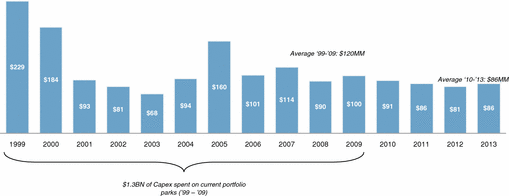
Historic capital spending averaged $120 million a year for the past decade, with approximately $1.3 billion of total spending. Since the new management team has taken over, annual Capex spending has been reduced. Going forward, current management has committed to Capex in a range of $80-$100 million per year. In addition, capital spending can be reduced if the liquidity profile should become less favorable.
Liquidity
Liquidity
The Company’s unrestricted cash balance is forecasted to remain at least $40 million during the projection period, with the Exit Revolving Credit Facility mostly undrawn throughout the year. The Company’s revolver is used during the off-season to fund working capital and capital spending initiatives, with trough liquidity usually in the month of May of each year (see the chart set forth below).
Additionally, the New TW Loan provides a funding source for Partnership Park put obligations. This facility represents additional stability and certainty in the Company’s capital structure.

Trough liquidity(2) ($ thousands)
|
|
|
2010 |
|
2011 |
|
|||||||||||||||||
|
|
|
Apr |
|
May |
|
Jan |
|
Feb |
|
Mar |
|
Apr |
|
May |
|
|||||||
|
Proj. Revolver |
|
$ |
87,976 |
|
$ |
96,449 |
|
$ |
4,936 |
|
$ |
39,100 |
|
$ |
90,867 |
|
$ |
96,192 |
|
$ |
114,493 |
|
|
|
|
|
|
|
|
|
|
|
|
|
|
|
|
|
|
|||||||
|
Proj. Revolver Availability |
|
$ |
62,024 |
|
$ |
53,551 |
|
$ |
145,064 |
|
$ |
110,900 |
|
$ |
59,133 |
|
$ |
53,808 |
|
$ |
35,507 |
|
|
Unrestricted cash balance |
|
40,000 |
|
40,000 |
|
40,000 |
|
40,000 |
|
40,000 |
|
40,000 |
|
40,000 |
|
|||||||
|
Projected Liquidity |
|
$ |
102,024 |
|
$ |
93,551 |
|
$ |
185,064 |
|
$ |
150,900 |
|
$ |
99,133 |
|
$ |
93,808 |
|
$ |
75,507 |
|
(1) Net of proceeds from property insurance recoveries
(2) Projected with no excess cash flow sweep of the Term Loan, for illustrative purposes
13 Appendix
Definitions: Modified EBITDA, Adjusted EBITDA, and Free Cash Flow
The Company uses “Adjusted EBITDA”, “Modified EBITDA” and “Free Cash Flow” to assess the operating results and effectiveness of its business. These terms presented in this Presentation are supplemental measures of performance that are not required by, or recognized as being in accordance with, United States generally accepted accounting principles (“GAAP”). The Company believes that Adjusted EBITDA, Modified EBITDA and Free Cash Flow provide useful information to investors regarding its operating performance and its capacity to incur and service debt and fund capital expenditures. The Company believes that Adjusted EBITDA, Modified EBITDA and Free Cash Flow are used by many investors, analysts and rating agencies as a measure of performance. Adjusted EBITDA, Modified EBITDA and Free Cash Flow are not defined by GAAP and should not be considered in isolation or as alternatives to net income (loss), net income (loss) attributable to Six Flags, Inc., net cash provided by (used in) operating, investing and financing activities or any other financial data prepared in accordance with GAAP or as an indicator of its operating performance. Adjusted EBITDA, Modified EBITDA and Free Cash Flow as defined in this Presentation may differ from similarly titled measures presented by other companies. This information should be read in conjunction with the consolidated statements of operations and statements of cash flows contained in the Company’s Consolidated Financial Statements, which are included in its filings with the U.S. Securities and Exchange Commission (the “SEC”), including its most recent Annual Report on Form 10-K and Quarterly Report on Form 10-Q.
Modified EBITDA
Defined as Adjusted EBITDA plus the interests of third parties in the Adjusted EBITDA of the four parks that are less than wholly owned less the Company’s interest in the Adjusted EBITDA of Six Flags Great Escape Lodge & Indoor Waterpark and dcp.
Adjusted EBITDA
Defined as net income (loss) attributable to Six Flags, Inc. before cumulative effect of changes in accounting principles, discontinued operations, income tax expense (benefit), other expense, early repurchase of debt (formerly an extraordinary loss), equity in operations of partnerships, net income (loss) attributable to non controlling interests, interest expense (net), amortization, depreciation, non-cash deferred and stock-based compensation, gain (loss) on disposal of assets, interests of third parties in the Adjusted EBITDA of four parks that are less than wholly owned (consisting of Six Flags Over Georgia, Six Flags Over Texas, Six Flags White Water Atlanta, and Six Flags Discovery Kingdom (formerly Six Flags Marine World, the minority interest in which we purchased in July 2007), plus the Company’s interest in the Adjusted EBITDA of Six Flags Great Escape Lodge & Indoor Waterpark (“HWP”) and dick clark productions, inc (“dcp”).
Free Cash Flow
Defined as Adjusted EBITDA excluding (i) cash interest expense (net) and debt issuance costs, dividends and taxes paid in cash and (ii) capital expenditures, net of property insurance recoveries. In the analyses included herein, Modified EBITDA, Adjusted EBITDA and Free Cash Flow all exclude the costs of the change in corporate management that occurred in December 2005 (approximately $13.9 million recognized as expense in 2006).
Cash Operating Expense
Operating expenses excluding depreciation, amortization, stock-based compensation and gain/loss on disposal of assets
Adjusted EBITDA, Modified EBITDA and Free Cash Flow have important limitations as analytical tools and you should not consider them in isolation or as substitutes for analysis of the Company’s results as reported under GAAP. For example, Adjusted EBITDA:
|
|
· |
excludes certain tax payments that may represent a reduction in cash available; |
|
|
|
|
|
|
· |
does not reflect any cash capital expenditure requirements for assets being depreciated and amortized that may have to be replaced in the future |
|
|
|
|
|
|
· |
does not reflect significant interest expense, or cash requirements necessary to service interest or principal payments on the Company’s debts. |
Additionally, Adjusted EBITDA, Modified EBITDA and Free Cash Flow do not reflect changes in or cash requirements for working capital.
Certain of these items can represent a reduction of cash that could be used for other corporate purposes. Because of these limitations investors should rely primarily on the Company’s GAAP results and use Adjusted EBITDA, Modified EBITDA and Free Cash Flow only as supplemental information.
The following reconciles Modified EBITDA, Adjusted EBITDA and Free Cash Flow with net income (loss):
($ thousands)
|
|
|
Historical |
|
Projected |
|
|||||||||||||||||||||||
|
|
|
2005 |
|
2006 |
|
2007 |
|
2008 |
|
2009 |
|
2010 |
|
2011 |
|
2012 |
|
2013 |
|
|||||||||
|
Net income (loss) attributable to Six Flags, Inc. |
|
$ |
(116,202 |
) |
$ |
(311,471 |
) |
$ |
(259,648 |
) |
$ |
(119,817 |
) |
$ |
(207,843 |
) |
$ |
(86,754 |
) |
$ |
4,354 |
|
$ |
24,718 |
|
$ |
41,372 |
|
|
Noncontrolling interests in earnings (loss) |
|
39,794 |
|
40,223 |
|
39,684 |
|
40,728 |
|
35,072 |
|
32,629 |
|
30,549 |
|
28,316 |
|
26,016 |
|
|||||||||
|
Net income (loss) |
|
(76,408 |
) |
(271,248 |
) |
(219,964 |
) |
(79,089 |
) |
(172,771 |
) |
(54,125 |
) |
34,903 |
|
53,034 |
|
67,388 |
|
|||||||||
|
Cumulative effect of a change in accounting principle |
|
— |
|
1,038 |
|
— |
|
— |
|
— |
|
— |
|
— |
|
— |
|
— |
|
|||||||||
|
Discontinued operations |
|
6,054 |
|
98,604 |
|
13,939 |
|
15,691 |
|
(1,478 |
) |
— |
|
— |
|
— |
|
— |
|
|||||||||
|
Income tax expense |
|
3,705 |
|
4,318 |
|
6,203 |
|
116,630 |
|
2,936 |
|
6,226 |
|
22,788 |
|
34,625 |
|
43,997 |
|
|||||||||
|
Other expense |
|
10,879 |
|
11,566 |
|
20,122 |
|
14,627 |
|
18,965 |
|
3,000 |
|
3,000 |
|
2,370 |
|
2,603 |
|
|||||||||
|
Reorganization expense |
|
— |
|
— |
|
— |
|
— |
|
109,174 |
|
63,661 |
|
— |
|
— |
|
— |
|
|||||||||
|
Net (gain) loss on debt extinguishment |
|
19,303 |
|
— |
|
13,210 |
|
(107,743 |
) |
— |
|
— |
|
— |
|
— |
|
— |
|
|||||||||
|
Equity in operations of partnerships |
|
— |
|
948 |
|
502 |
|
806 |
|
(1,908 |
) |
(2,450 |
) |
(2,550 |
) |
(2,650 |
) |
(2,750 |
) |
|||||||||
|
Interest expense (net) |
|
188,683 |
|
205,761 |
|
204,132 |
|
183,028 |
|
105,301 |
|
56,827 |
|
52,409 |
|
49,639 |
|
47,712 |
|
|||||||||
|
Loss on disposal of assets |
|
13,741 |
|
27,057 |
|
39,243 |
|
17,692 |
|
7,540 |
|
7,500 |
|
5,000 |
|
5,000 |
|
5,000 |
|
|||||||||
|
Amortization |
|
880 |
|
879 |
|
1,249 |
|
1,203 |
|
447 |
|
882 |
|
879 |
|
758 |
|
737 |
|
|||||||||
|
Depreciation |
|
123,937 |
|
130,620 |
|
136,657 |
|
138,406 |
|
142,200 |
|
148,295 |
|
154,195 |
|
159,762 |
|
165,328 |
|
|||||||||
|
Management change costs |
|
12,605 |
|
13,885 |
|
— |
|
— |
|
— |
|
— |
|
— |
|
— |
|
— |
|
|||||||||
|
Stock-based compensation |
|
2,794 |
|
15,728 |
|
12,525 |
|
6,202 |
|
2,730 |
|
23,288 |
|
10,401 |
|
6,254 |
|
1,478 |
|
|||||||||
|
Modified EBITDA |
|
306,173 |
|
239,156 |
|
227,818 |
|
307,453 |
|
213,136 |
|
253,104 |
|
281,025 |
|
308,792 |
|
331,493 |
|
|||||||||
|
Third party interest in Adj. EBITDA of certain parks |
|
(44,674 |
) |
(44,352 |
) |
(38,186 |
) |
(32,199 |
) |
(23,136 |
) |
(22,105 |
) |
(20,025 |
) |
(17,792 |
) |
(15,493 |
) |
|||||||||
|
|
|
|
|
|
|
|
|
|
|
|
|
|
|
|
|
|
|
|
|
|||||||||
|
Adjusted EBITDA |
|
261,499 |
|
194,804 |
|
189,632 |
|
275,254 |
|
190,001 |
|
230,999 |
|
261,000 |
|
291,000 |
|
316,001 |
|
|||||||||
|
|
|
|
|
|
|
|
|
|
|
|
|
|
|
|
|
|
|
|
|
|||||||||
|
Cash interest, net |
|
(178,900 |
) |
(187,620 |
) |
(196,446 |
) |
(157,478 |
) |
(82,870 |
) |
(46,797 |
) |
(47,693 |
) |
(43,949 |
) |
(42,022 |
) |
|||||||||
|
Capital expenditures, net |
|
(162,325 |
) |
(101,136 |
) |
(114,132 |
) |
(90,251 |
) |
(100,017 |
) |
(91,000 |
) |
(86,000 |
) |
(81,000 |
) |
(86,000 |
) |
|||||||||
|
PIERS Dividends paid |
|
(20,844 |
) |
(20,844 |
) |
(20,844 |
) |
(5,211 |
) |
— |
|
— |
|
— |
|
— |
|
— |
|
|||||||||
|
Cash paid for debt issuance costs |
|
(5,540 |
) |
(2,950 |
) |
(19,127 |
) |
(9,688 |
) |
— |
|
— |
|
— |
|
— |
|
— |
|
|||||||||
|
Cash taxes |
|
(4,883 |
) |
(4,702 |
) |
(5,047 |
) |
(7,019 |
) |
(9,011 |
) |
(10,000 |
) |
(10,000 |
) |
(10,000 |
) |
(10,000 |
) |
|||||||||
|
|
|
|
|
|
|
|
|
|
|
|
|
|
|
|
|
|
|
|
|
|||||||||
|
Free Cash Flow |
|
$ |
(110,993 |
) |
$ |
(122,448 |
) |
$ |
(165,964 |
) |
$ |
5,607 |
|
$ |
(1,897 |
) |
$ |
83,202 |
|
$ |
117,307 |
|
$ |
156,051 |
|
$ |
177,979 |
|
|
|
|
|
|
|
|
|
|
|
|
|
|
|
|
|
|
|
|
|
|
|||||||||
|
Additional GAAP Measures: |
|
|
|
|
|
|
|
|
|
|
|
|
|
|
|
|
|
|
|
|||||||||
|
Cash Flow From Operating Activities |
|
$ |
165,838 |
|
$ |
56,309 |
|
$ |
9,655 |
|
$ |
107,657 |
|
$ |
109,807 |
|
$ |
57,694 |
|
$ |
215,948 |
|
$ |
250,202 |
|
$ |
276,230 |
|
|
Cash Flow From Investing Activities |
|
$ |
(37,147 |
) |
$ |
(40,016 |
) |
$ |
64,179 |
|
$ |
(93,678 |
) |
$ |
(85,898 |
) |
$ |
(91,000 |
) |
$ |
(92,000 |
) |
$ |
(90,000 |
) |
$ |
(86,000 |
) |
|
Cash Flow From Financing Activities |
|
$ |
(116,735 |
) |
$ |
(72,399 |
) |
$ |
(70,085 |
) |
$ |
169,746 |
|
$ |
(64,520 |
) |
$ |
(74,425 |
) |
$ |
(85,699 |
) |
$ |
(72,613 |
) |
$ |
(62,516 |
) |
Description of major parks
Six Flags America — Largo, Maryland

Six Flags America is a combination theme and water park located in Largo, Maryland (approximately 15 miles east of Washington, D.C. and 30 miles southwest of Baltimore, Maryland). The park’s primary market includes Maryland, northern Virginia, Washington, D.C. and parts of Pennsylvania and Delaware. This market provides the park with a permanent resident population of approximately 7.0 million people within 50 miles and 11.7 million people within 100 miles. Based on a 2008 survey of television households within designated market areas (“DMAs”) published by A.C. Nielsen Media Research, the Washington, D.C. and Baltimore markets are the number 9 and number 24 DMAs in the United States, respectively. Six Flags America is located on a site of 523 acres, with approximately 300 acres available for future development including the potential to develop complementary operations. Six Flags America’s principal competitors are King’s Dominion Park, located in Doswell, Virginia (near Richmond); Hershey Park, located in Hershey, Pennsylvania; and Busch Gardens, located in Williamsburg, Virginia. These parks are located approximately 120, 125 and 175 miles, respectively, from Six Flags America.
Six Flags Discovery Kingdom — Vallejo, California

Six Flags Discovery Kingdom (formerly Six Flags Marine World) features rides, marine mammals and land animals and is located in Vallejo, California, approximately 30 miles from San Francisco, 20 miles from Oakland and 60 miles from Sacramento. This market provides the park with a permanent resident population of approximately 5.5 million people within 50 miles and approximately 10.2 million people within 100 miles. The San Francisco/Oakland and Sacramento areas are the number 6 and number 20 DMAs in the United States, respectively. Prior to July 2007, the Company operated the park in a partnership with the City of Vallejo. In July 2007, the Company purchased all of the City of Vallejo’s interest in the park for approximately $52.8 million. Six Flags Discovery Kingdom is located on approximately 138 acres and offers various rides and other traditional theme park attractions, as well as presentation stadiums, animal habitats and picnic areas, bordering a 55-acre man-made lake. The park provides shelter and care for marine mammals, land animals, sharks, birds and reptiles, tropical and cold water fish and marine invertebrates, all featured in a variety of exhibits and participatory attractions. Six Flags Discovery Kingdom’s principal competitors are Aquarium of the Bay at Pier 39 in San Francisco, Great America in Santa Clara, Gilroy Gardens in Gilroy and Outer Bay at Monterey Bay Aquarium. These attractions are located approximately 30, 60, 100 and 130 miles from Six Flags Discovery Kingdom, respectively.
Six Flags Fiesta Texas — San Antonio, Texas
Six Flags Fiesta Texas is a combination theme and water park located on approximately 224 acres in San Antonio, Texas. The San Antonio, Texas market provides the park with a permanent resident population of approximately 2.1 million people within 50 miles and approximately 3.7 million people within 100 miles. The San Antonio market is the number 37 DMA in the United States. Six Flags Fiesta Texas’ principal competitor is Sea World of Texas, also located in San Antonio. In addition, the park competes to a lesser degree with Schlitterbahn, a water park located in New Braunfels, Texas (approximately 33 miles from the park) and Six Flags Over Texas, located in Arlington, Texas (approximately 285 miles from the park).
Six Flags Great Adventure, Six Flags Hurricane Harbor and Six Flags Wild Safari — Jackson, New Jersey
Six Flags Great Adventure, the separately gated adjacent Six Flags Hurricane Harbor, and Six Flags Wild Safari are each located in Jackson, New Jersey, approximately 70 miles south of New York City and 50 miles northeast of Philadelphia. The New York and Philadelphia markets provide the parks with a permanent resident population of approximately 13.7 million people within 50 miles and approximately 27.2 million people within 100 miles. The New York and Philadelphia markets are the number 1 and number 4 DMAs in the United States, respectively. These parks are located on a site of approximately 2,200 acres, of which approximately 700 acres are available for future development. The animal park is home to over 1,200 animals representing more than 55 species, which can be seen over a four and one-half mile drive. Six Flags Great Adventure’s principal competitors are Hershey Park, located in Hershey, Pennsylvania, approximately 150 miles from the park and Dorney Park, located in Allentown, Pennsylvania, approximately 75 miles from the park. The water park competes with several other water parks in the market.

Six Flags Great
Adventure
World’s tallest coaster

|
· Location: Six Flags Great Adventure · Type: Steel Rocket · Status: Operating since 2005 · Designer: Intamin · Features: Hydraulic Launch, Vertical · Height: 456 feet · Max Drop: 418 feet · Max Speed: 128 mph · Length: 3,118 feet · Duration: 0.51 · Trains: 4 · Capacity: 1,400 per hour · Features: 128 mph in 3.5 seconds |
|

Six Flags Great
Adventure
steepest wooden drop in the world

|
· Location: Six Flags Great Adventure · Type: Wood · Status: Operating since 2006 · Designer: Intamin · Features: Elevator Cable Lift, Prefabricated Track · Height: 181 feet · Max Drop: 176 feet · Max Speed: 70 mph · Length: 4440 feet · Duration: 1.40 · Trains: 2 · Capacity: 1,500 per hour · Features: 76-degree first drop - steepest wooden drop in the world |
Six Flags Great America — Gurnee, Illinois

Six Flags Great America is a combination theme and water park, located in Gurnee, Illinois, between Chicago, Illinois and Milwaukee, Wisconsin. The Chicago and Milwaukee markets provide the park with a permanent resident population of approximately 8.5 million people within 50 miles and approximately 13.1 million people within 100 miles. The Chicago and Milwaukee markets are the number 3 and number 35 DMAs in the United States, respectively. Six Flags Great America is located on a site of approximately 304 acres of which approximately 20 acres are available for future development. Six Flags Great America currently has no direct theme park competitors in the region, but does compete to some extent with Kings Island, located near Cincinnati, Ohio, approximately 350 miles from the park; Cedar Point, located in Sandusky, Ohio, approximately 340 miles from the park; and Six Flags St. Louis, a Company owned park located outside St. Louis, Missouri, approximately 320 miles from the park. The water park competes with numerous water parks in the Wisconsin Dells area, approximately 170 miles from the park.
Six Flags Kentucky Kingdom — Louisville, Kentucky
Six Flags Kentucky Kingdom is a combination theme and water park, located on approximately 58 acres adjacent to the grounds of the Kentucky Fair and Exposition Center in Louisville, Kentucky. Of the 58 acres, approximately 38 acres are leased under ground leases with terms (including renewal options) expiring between 2021 and 2049, with the balance owned by the Company. The park’s primary market includes Louisville and Lexington, Kentucky, Evansville and Indianapolis, Indiana and Nashville, Tennessee. This market provides the park with a permanent resident population of approximately 1.4 million people within 50 miles and approximately 4.6 million people within 100 miles. The Louisville and Lexington markets are the number 50 and number 63 DMAs in the United States. Six Flags Kentucky Kingdom’s significant direct competitors are Kings Island, located near Cincinnati, Ohio, approximately 130 miles from the park and Holiday World located in Santa Claus, Indiana, approximately 75 miles from the park.
Six Flags Magic Mountain and Six Flags Hurricane Harbor — Valencia, California

Six Flags Magic Mountain, and the separately gated adjacent Six Flags Hurricane Harbor are located in Valencia, California, 30 miles north of Los Angeles. The Los Angeles, California market provides the parks with a permanent resident population of approximately 10.6 million people within 50 miles and approximately 17.8 million people within 100 miles. The Los Angeles market is the number 2 DMA in the United States. The parks are located on a site of approximately 262 acres. Six Flags Magic Mountain’s principal competitors include Disneyland and Disney’s California Adventure, each in Anaheim, California, located approximately 60 miles from the park, Universal Studios Hollywood in Universal City, California, located approximately 20 miles from the park, Knott’s Berry Farm in Buena Park, California, located approximately 50 miles from the park, Sea World of California in San Diego, California, located approximately 150 miles from the park and Legoland in Carlsbad, California, located approximately 130 miles from the park. Six Flags Hurricane Harbor’s competitors include Soak City USA Waterpark and Raging Waters, each located approximately 50 miles from the water park.
Six Flags Magic Mountain
World’s tallest, fastest, and longest flying coaster
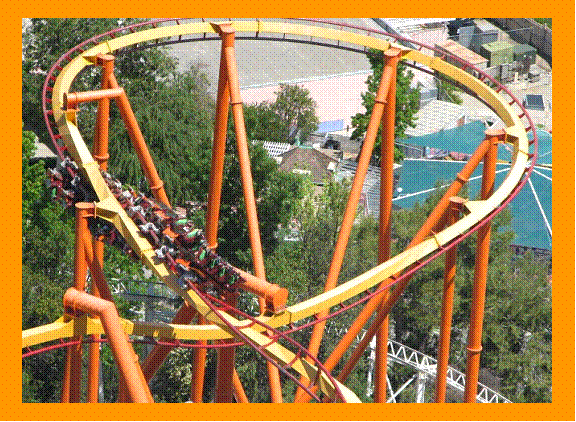
|
· Location: Six Flags Magic Mountain · Type: Steel Flying · Status: Operating since 2006 · Designer: Bolliger and Mabillard · Features: Terrain · Height: 170 feet · Max Drop: 111 feet · Max Speed: 62 mph · Length: 3602 feet · Inversions: 4 · Trains: 3 · Capacity: 1,600 per hour · Features: Total elevation change 263 feet |
|
Six Flags
Magic Mountain
Only 4th dimension coaster in the U.S
|
· Location: Six Flags Magic Mountain · Type: Steel 4th Dimension · Status: Operating since 2001 · Designer: Arrow · Features: Rotating Trains, Themed, Vertical · Height: 186 feet · Max Drop: 202 feet · Max Speed: 76 mph · Length: 3610 feet · Inversions: 6 · Trains: 3 · Capacity: 1,600 per hour |
|
Six Flags Mexico — Mexico City
In May 1999, the Company acquired Reino Aventura, the largest paid admission theme park in Mexico, which was rebranded as Six Flags Mexico in 2000. The park first opened in 1982 and is located on approximately 110 acres in Mexico City, which the Company occupies on a long-term basis pursuant to a concession agreement with the Federal District of Mexico. The park’s primary market includes Mexico City, Cuernavaca, Puebla and Toluca. This market provides the park with a permanent resident population of approximately 30 million people within 50 miles of the park and approximately 42 million people within 100 miles of the park. Six Flags Mexico’s principal competitors are the Mexico City Zoo and Chapultepec, an amusement park located in Mexico City.
Six Flags New England — Springfield, Massachusetts

Six Flags New England is a combination theme and water park, located off Interstate 91 near Springfield, Massachusetts, approximately 90 miles west of Boston. The primary market for Six Flags New England includes Springfield and western Massachusetts, Hartford and western Connecticut, as well as portions of eastern Massachusetts (including Boston) and eastern New York. This market provides the park with a permanent resident population base of approximately 3.1 million people within 50 miles and 15.2 million people within 100 miles. Springfield, Providence, Hartford/New Haven and Boston are the number 111, number 52, number 30 and number 7 DMAs in the United States, respectively. Six Flags New England is comprised of approximately 284 acres.
A substantial portion of the excess land is not suitable for development due to wetlands and other restrictions. Six Flags New England’s significant direct competitor is Lake Compounce located in Bristol, Connecticut, approximately 50 miles from Six Flags New England. To a lesser extent, Six Flags New England competes with The Great Escape, a Company owned park located in Lake George, New York, approximately 150 miles from Six Flags New England.
Six Flags New
England
Has won Amusement Today’s prestigious Golden Ticket Award for Best Steel
Coaster in the world a record 5 times!

|
· Location: Six Flags New England · Type: Steel Hyper · Status: Operating since 2000 · Designer: Intamin · Features: 2 Underground Tunnels, Themed · Height: 208 feet · Max Drop: 221 feet · Max Speed: 77 mph · Length: 5,400 feet · Duration: 2.30 · Trains: 2 |
|
Six Flags St. Louis — Eureka, Missouri
Six Flags St. Louis is a combination theme and water park located in Eureka, Missouri, about 35 miles west of St. Louis, Missouri. The St. Louis market provides the park with a permanent resident population of approximately 2.6 million people within 50 miles and approximately 3.8 million people within 100 miles. The St. Louis market is the number 21 DMA in the United States. The Company owns a site of approximately 497 acres of which approximately 240 acres are available for future development. Six Flags St. Louis competes with Kings Island, located near Cincinnati, Ohio, approximately 350 miles from the park; Worlds of Fun in Kansas City, Missouri, located approximately 250 miles from the park; Cedar Point, located in Sandusky, Ohio, approximately 515 miles from the park; Silver Dollar City, located in Branson, Missouri, approximately 250 miles from the park; and Six Flags Great America, a Company owned park located near Chicago, Illinois, approximately 320 miles from the park.
La Ronde — Montreal

La Ronde, a theme park located in the City of Montreal, is located on the 146 acre site of the 1967 Montreal World’s Fair. Montreal has a metropolitan population of approximately 3.7 million and is a major tourist destination. This market provides the park with a permanent resident population of approximately 4.3 million people within 50 miles of the park and 5.8 million people within 100 miles. The park’s competitors are the Quebec City Water Park, a Company owned park located in Lake George, The Great Escape, and Canada’s Wonderland, approximately 130, 170 miles and 370 miles respectively from La Ronde.
The Great Escape and Six Flags Great Escape Lodge & Indoor Waterpark — Lake George, New York resort area

The Great Escape, which opened in 1954, is a combination theme and water park located off Interstate 87 in the Lake George, New York resort area, 180 miles north of New York City and 40 miles north of Albany. The park’s primary market includes the Lake George tourist population and the upstate New York and western New England resident population. This market provides the park with a permanent resident population of approximately 1.1 million people within 50 miles of the park and 3.1 million people within 100 miles.
According to information released by local governmental agencies, more than 7.9 million tourists visited Warren County, which includes the Lake George area, in 2006. The Albany market is the number 57 DMA in the United States. In February 2006, the Company opened the Six Flags Great Escape Lodge & Indoor Waterpark, which is located across from The Great Escape & Splashwater Kingdom. In addition to a 200 suite hotel, the facility features a 38,000-square foot indoor water park. The facility is owned by a joint venture in which the Company holds an approximate 41% interest. The Company also manages the facility for a management fee equal to 3% of the hotel’s gross receipts and receives a guaranteed payment equal to 2% of the hotel’s gross receipts for certain other services. The Great Escape is located on a site of approximately 351 acres. The Great Escape’s primary direct competitor is Six Flags New England, a Company owned park located near Springfield, Massachusetts, approximately 150 miles from The Great Escape. In addition, there is a smaller water park located in Lake George.
Six Flags Over Georgia and Six Flags White Water Atlanta
Six Flags Over Georgia is located on approximately 290 acres, 20 miles outside of Atlanta, Georgia. The Atlanta, Georgia market provides the park with a permanent resident population of approximately 4.2 million people within 50 miles and approximately 7.0 million people within 100 miles. The Atlanta market is the number 8 DMA in the United States. In May 1999, the partnership that owns Six Flags Over Georgia purchased White Water Atlanta, a water park and related entertainment park located approximately 20 miles from the theme park. Six Flags White Water Atlanta is located on approximately 69 acres. Six Flags Over Georgia’s primary competitors include the Georgia Aquarium located in Atlanta, Georgia, Carowinds in Charlotte, North Carolina, located approximately 250 miles from the park, Alabama Adventure in Birmingham, Alabama, located approximately 160 miles from the park, Dollywood in Pigeon Forge, Tennessee, located approximately 200 miles from the park and Wild Adventures in Valdosta, Georgia, located approximately 240 miles from the park. Six Flags White Water’s primary competitors include Sun Valley Beach in Powder Springs, Georgia, Atlanta Beach in Jonesboro, Georgia, Lake Lanier Islands Resort in Lake Lanier Islands, Georgia and Dollywood’s Splash Country in Pigeon Forge, Tennessee. These competitors are located approximately 15, 40, 45 and 250 miles away from the water park, respectively. The Georgia Limited Partner owns the theme park site of approximately 290 acres, including approximately 50 acres of usable, undeveloped land, all of which is leased to Six Flags Over
Georgia II, L.P. (the “Georgia Partnership”). The Georgia park is owned (excluding real property) by the Georgia Partnership of which the Company’s wholly-owned subsidiary is the 1% managing general partner. The 99% limited partner (the “Georgia Limited Partner”) is unaffiliated with the Company except that the Company owns approximately 29% of the limited partnership units in the Georgia Limited Partner. The Company purchased approximately 25% of the units in a tender offer in 1997 at an aggregate price of $62.7 million. The Georgia partnership arrangements expire in 2027.
Six Flags Over Texas and Six Flags Hurricane Harbor
Six Flags Over Texas and the separately gated Six Flags Hurricane Harbor are located across Interstate 30 from each other in Arlington, Texas, between Dallas and Fort Worth, Texas. The Dallas/Fort Worth market provides the parks with a permanent resident population of approximately 6.5 million people within 50 miles and approximately 7.1 million people within 100 miles. The Dallas/ Fort Worth market is the number 5 DMA in the United States. Six Flags Over Texas’ principal competitors include Sea World of Texas and the Company owned Six Flags Fiesta Texas park, both located in San Antonio, Texas, approximately 285 miles from the park. Six Flags Hurricane Harbor’s primary competitors are NRH2O Waterpark in Richland Hills, Texas, and The Great Wolf Lodge in Grapevine, Texas. The Texas Limited Partner (as defined below) owns a site of approximately 217 acres of which 187 acres are used for the theme park. The 217 acres are leased to Texas Flags, Ltd. (the “Texas Partnership”). In addition, the Company directly owns approximately 47 acres, of which approximately 45 acres are currently used for Hurricane Harbor and 2 acres remain undeveloped. Six Flags Over Texas is owned (excluding real property) by the Texas Partnership, a limited partnership of which the 1% managing general partner is a Company wholly-owned subsidiary. The 99% limited partner (the “Texas Limited Partner”) is unaffiliated with the Company except that the Company owns approximately 52% of the limited partnership units in the Texas Limited Partner. The Company purchased approximately 33% of the units in a tender offer in 1998 at an aggregate price of $126.2 million. Six Flags Hurricane Harbor is 100% owned by the Company and is not included in these partnership arrangements. The Texas partnership arrangements expire in 2028.

